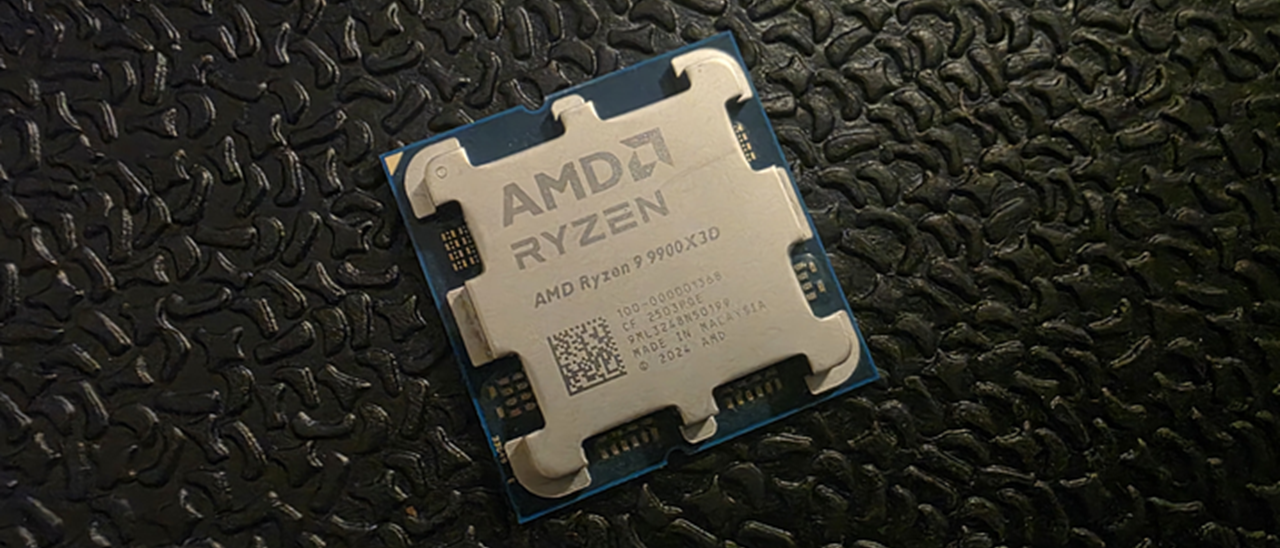Why you can trust Tom's Hardware
The new SPECworkstation 4 benchmark suite is designed to measure workstation performance in professional applications. The full suite consists of 23 workloads with 80 subtests that target four hardware subsystems.
This industry-standard benchmark measures performance across seven industry verticals, but we've winnowed down the list to tests that largely focus on CPU performance. We haven't submitted these benchmarks to the SPEC organization, so be aware that these are not official benchmarks.
Financial Services and Energy
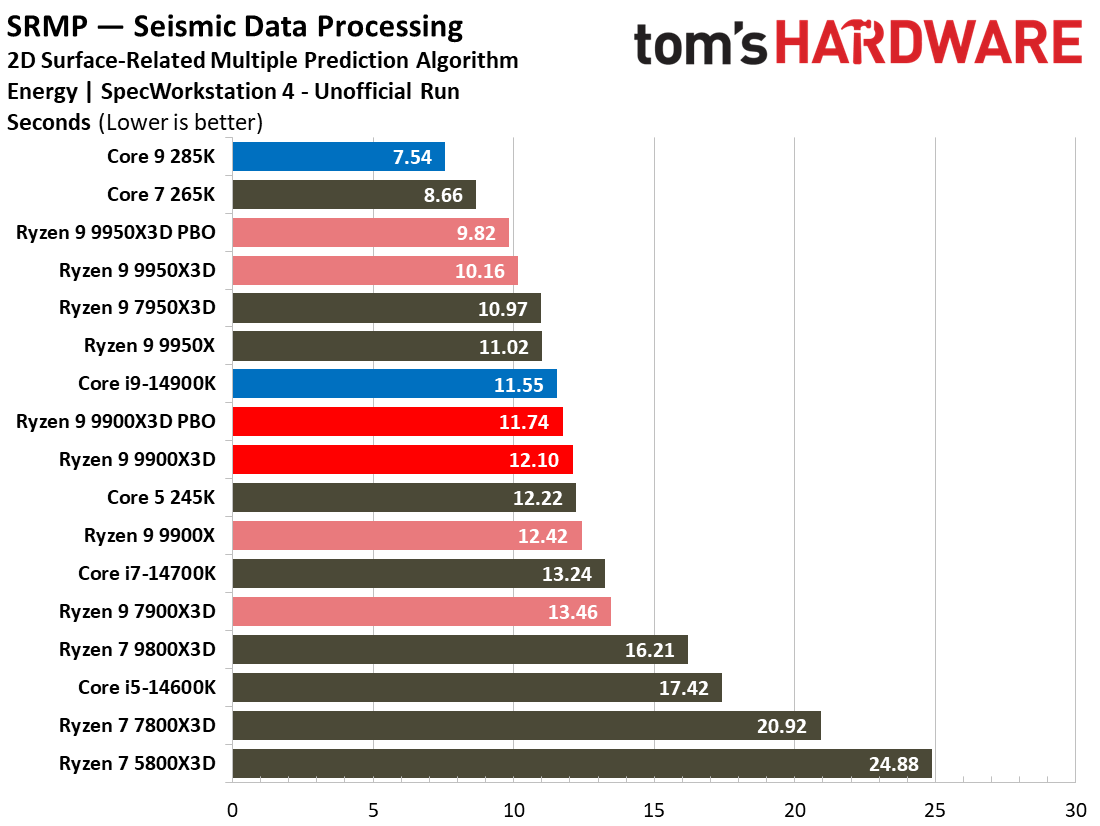
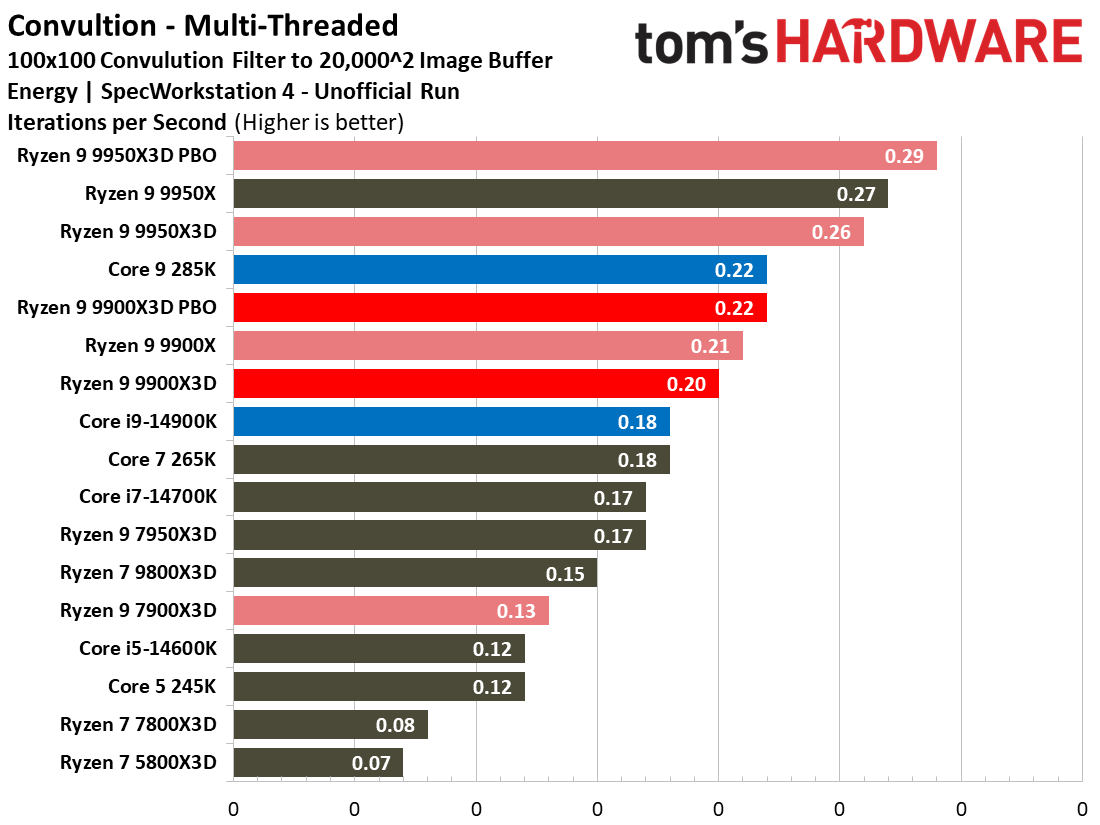
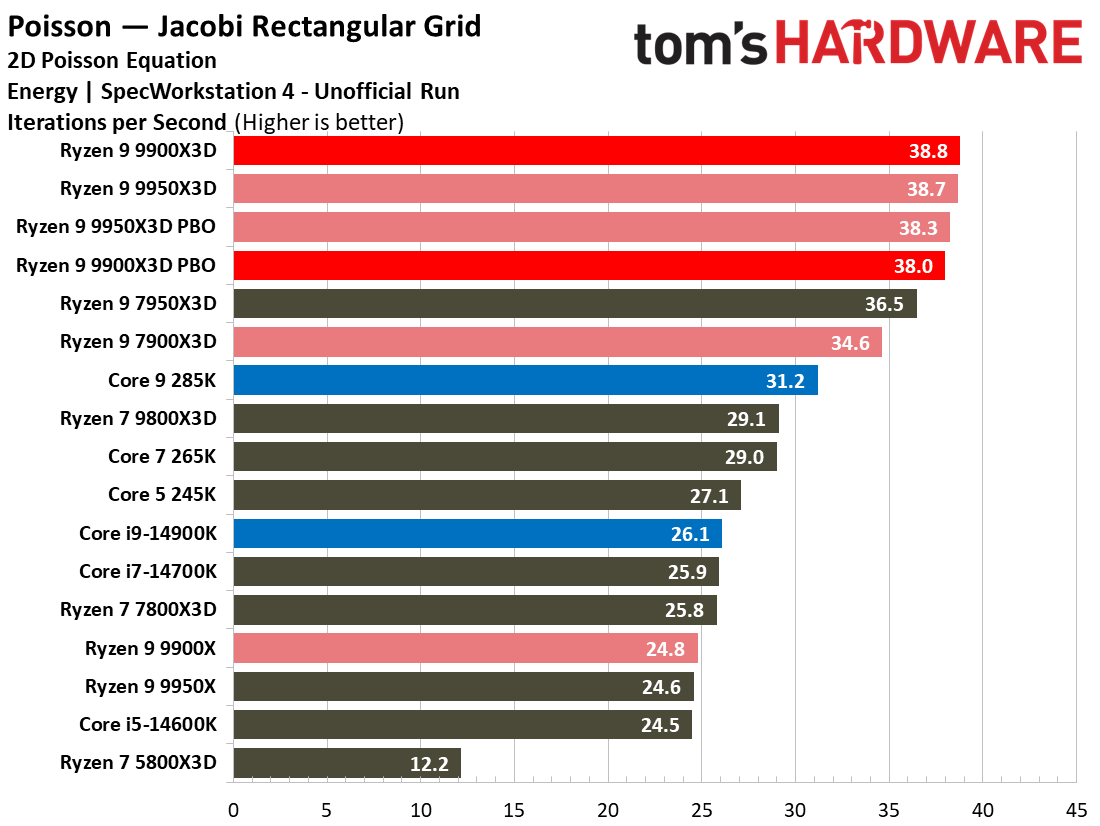
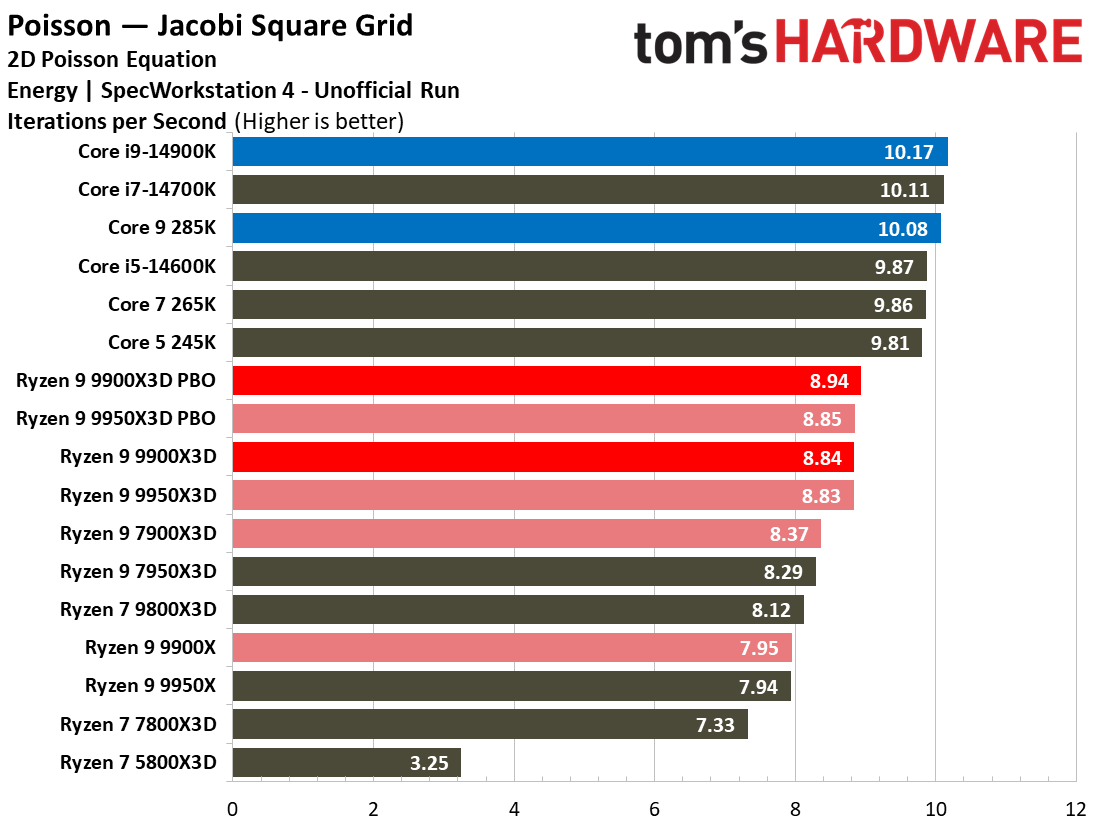

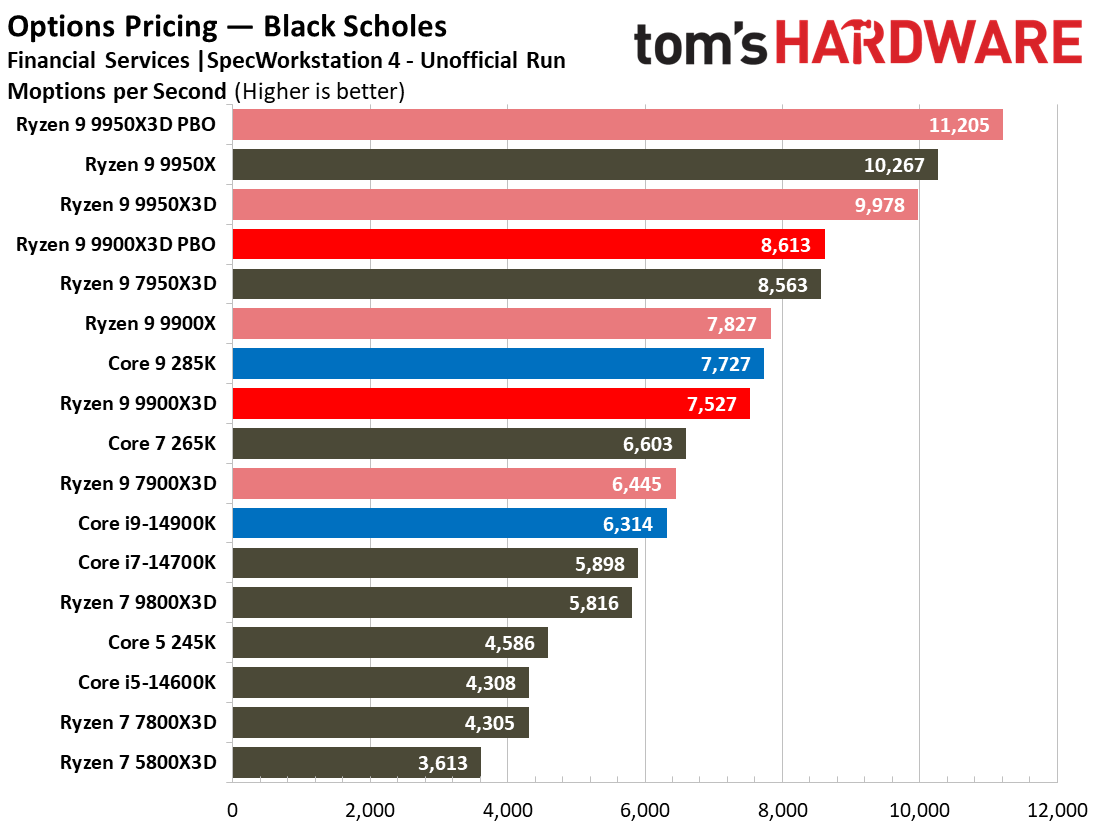
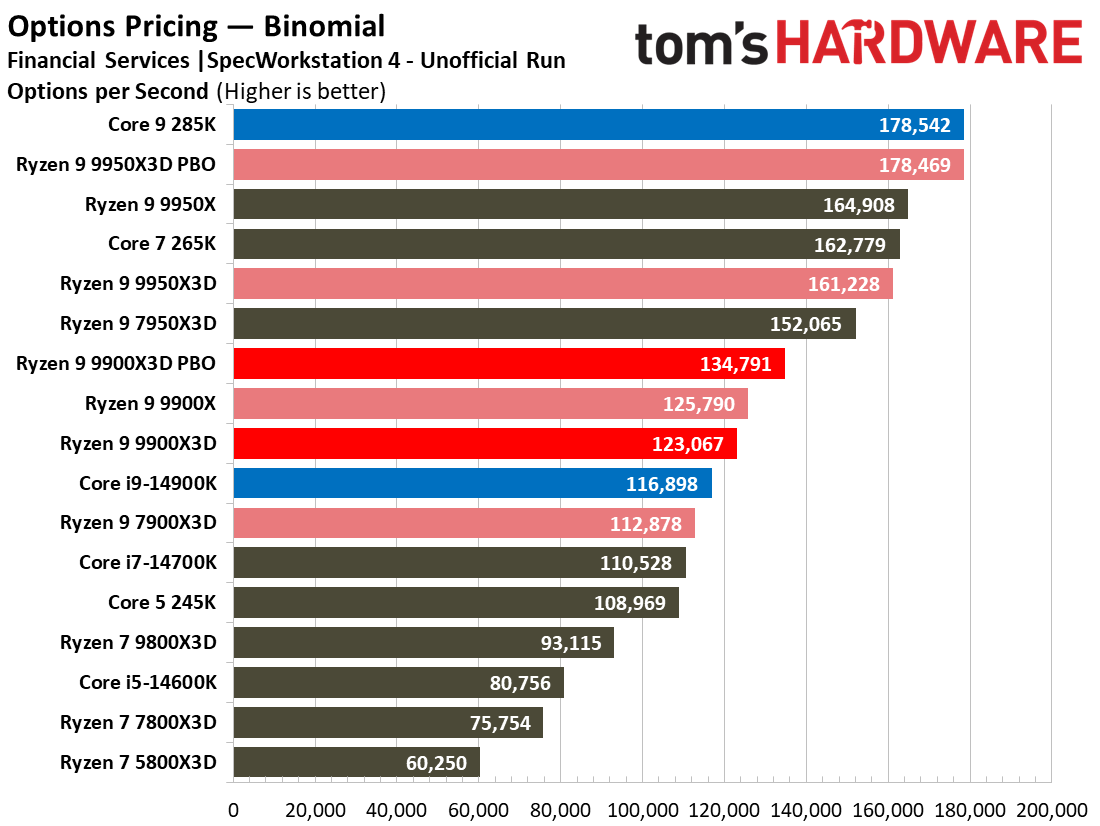
The Energy category of tests pertains to workloads commonly executed in energy-related industries, such as seismic data processing, reservoir simulations, and computational fluid dynamics (CFD). The Intel processors excel in the SRMP seismic data processing benchmark and the Poisson Jacobi Square Grid equation (used to simulate electrostatics, heat conduction, and fluid flow). The Ryzen 9 9900X3D is more competitive in the Convolution and Poisson Rectangular Square Grid benchmarks.
The Financial Services category measures performance in various financial applications and options pricing tasks, such as Monte Carlo probability simulations and Black Scholes pricing models. Here we can see that the Ryzen 9 9900X3D, and all of the X3D chips for that matter, perform well in these applications. This is most likely due to the additional L3 cache capacity. The Core Ultra 9 285K takes a convincing lead in the Binomial workload.
Product Design


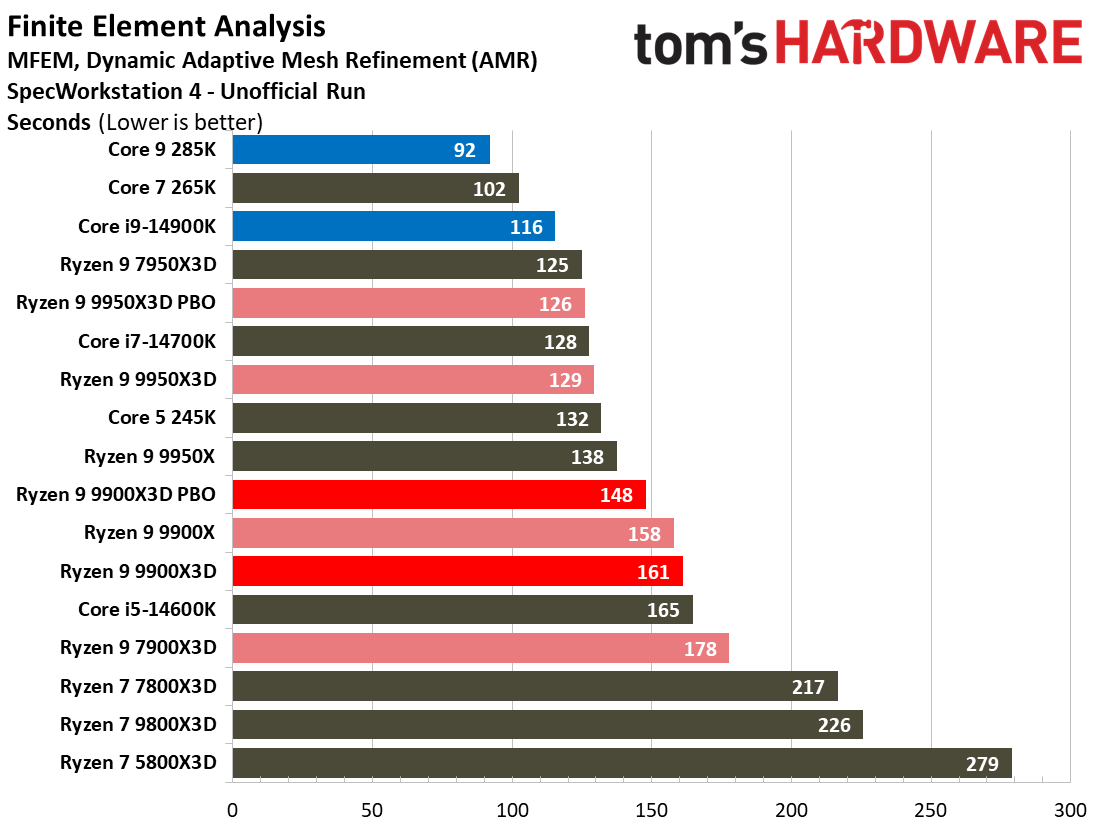
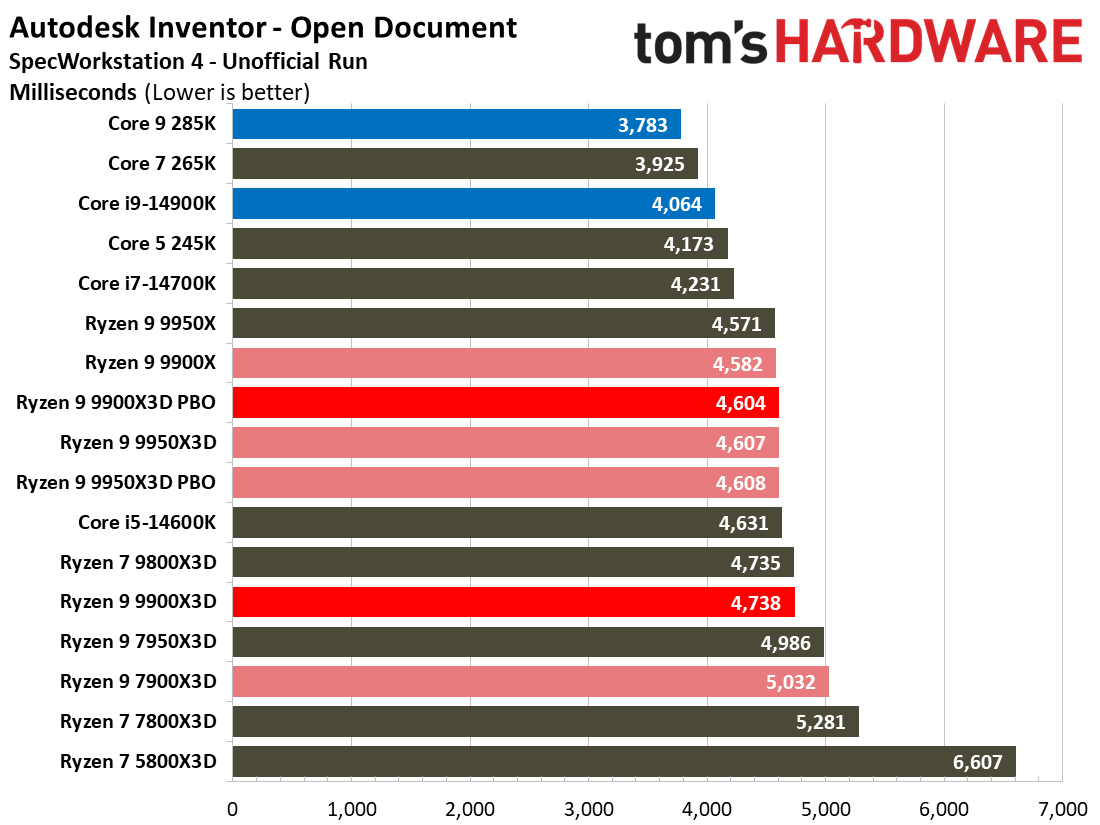
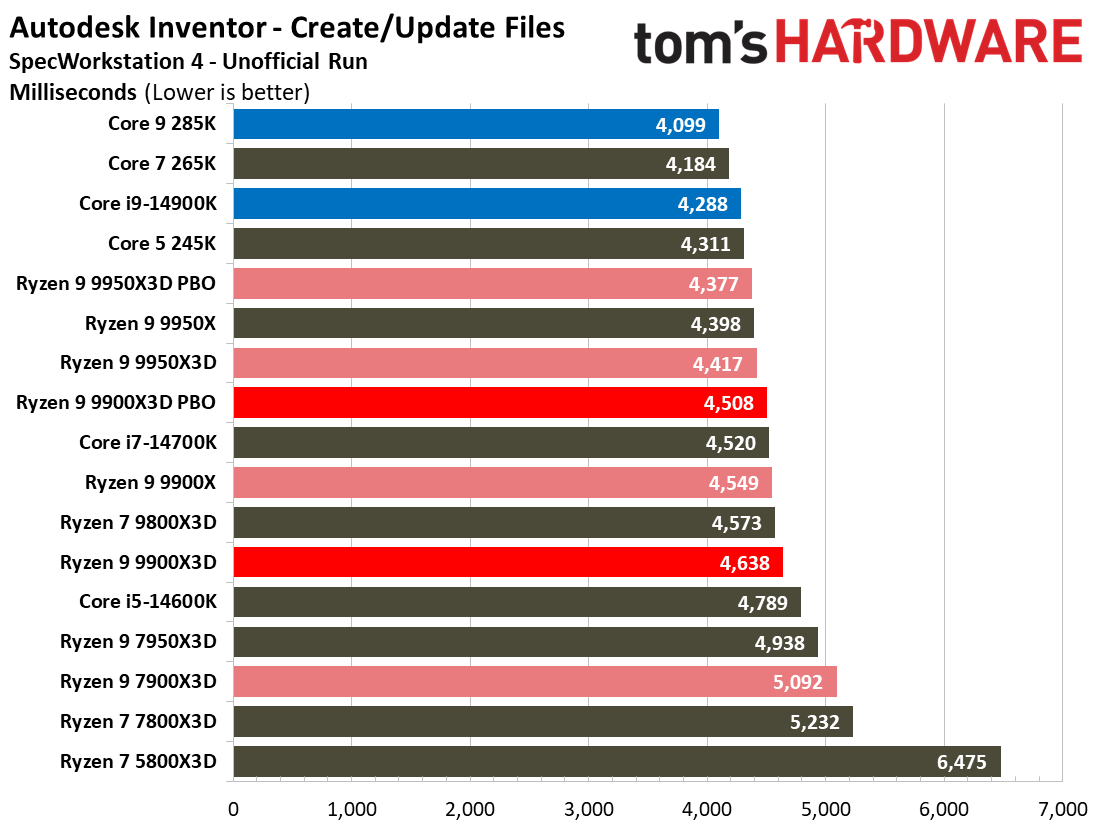

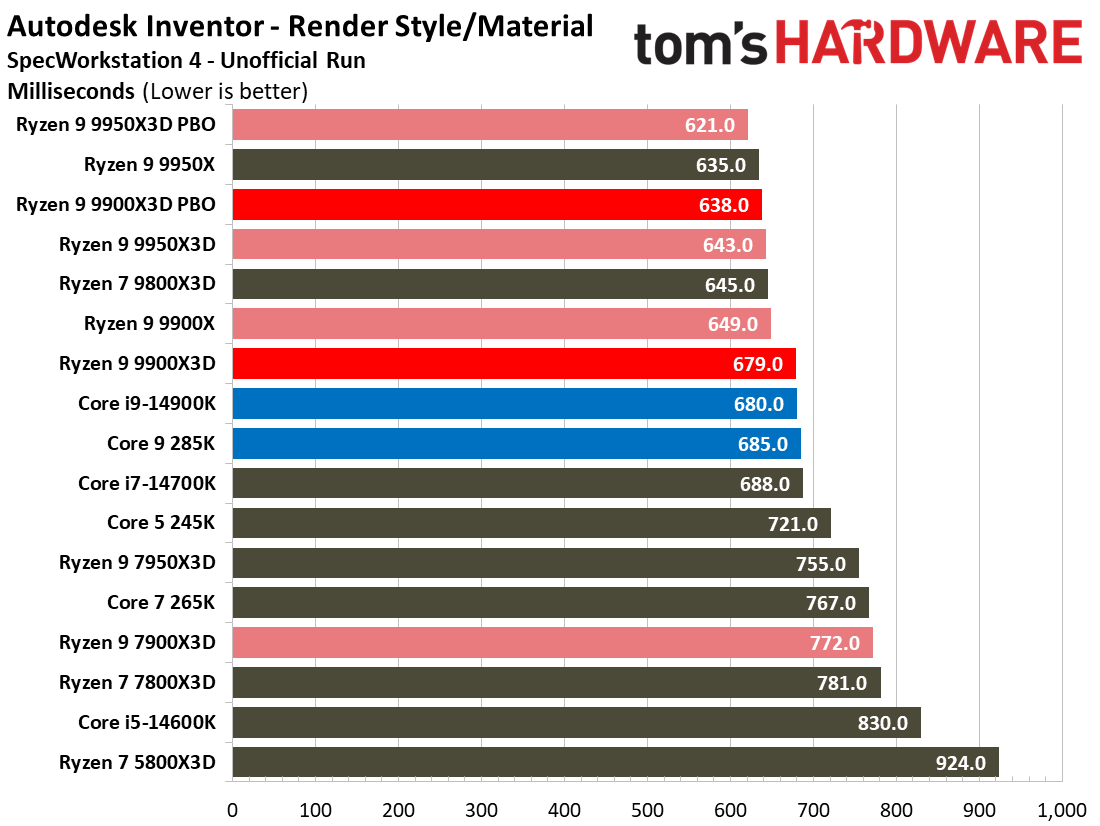
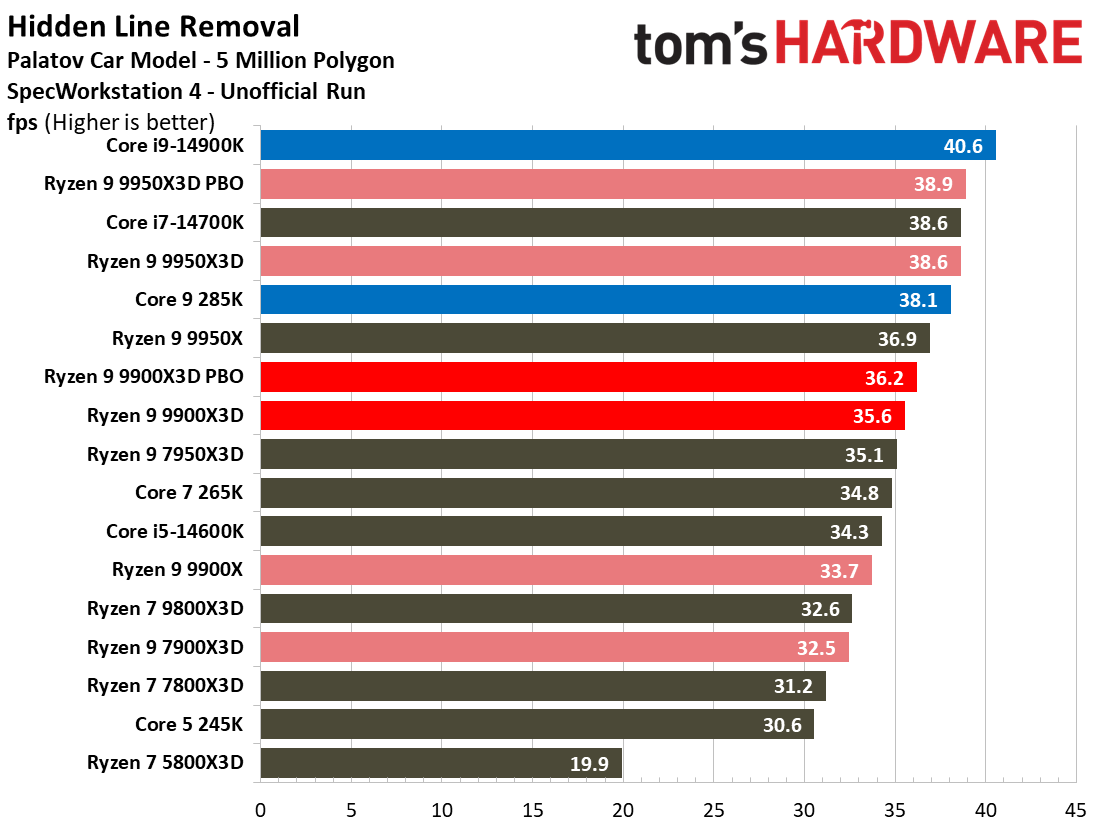
The Product Design vertical addresses workstation performance in common tasks for product designers and engineers, such as CAD and related applications used for 3D modeling, product visualizations, and design.
The Intel chips take a pronounced lead in most of these benchmarks, including AutoDesk Inventor, Finite Element Analysis (FEM), OpenFOAM CFD, Rodinia CFD, and the hidden line removal workload.
Productivity and Development
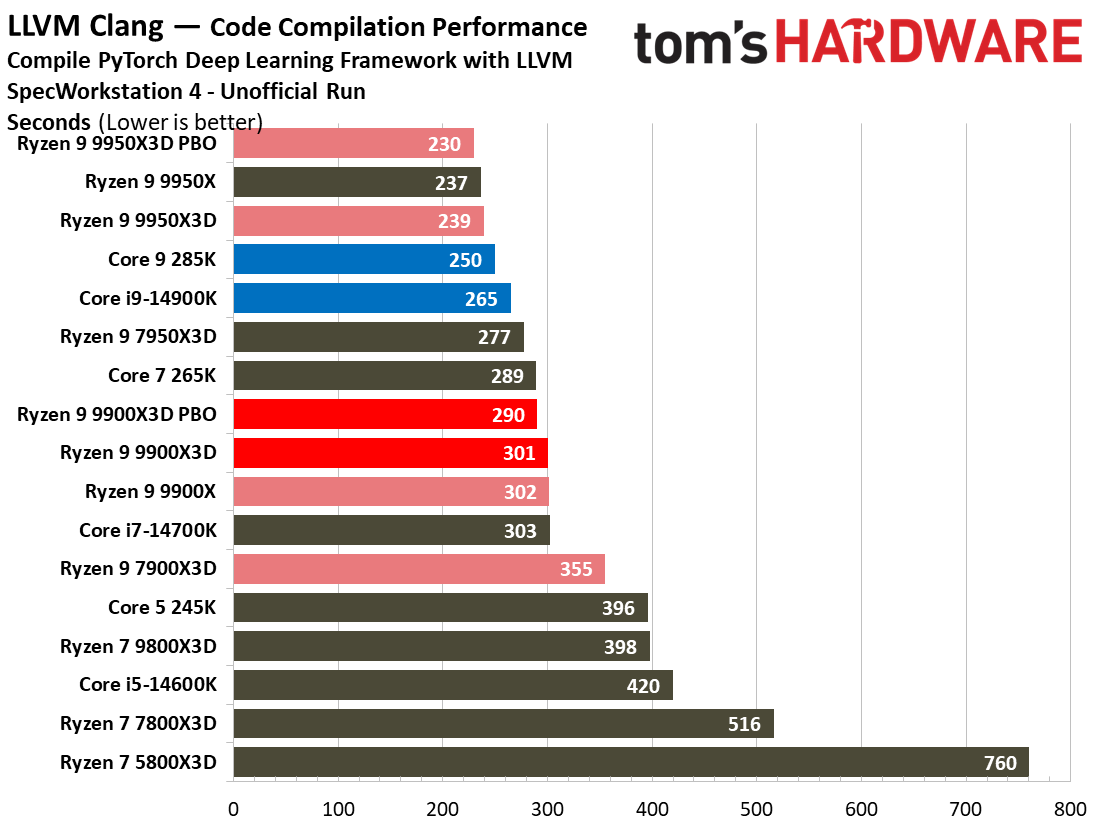
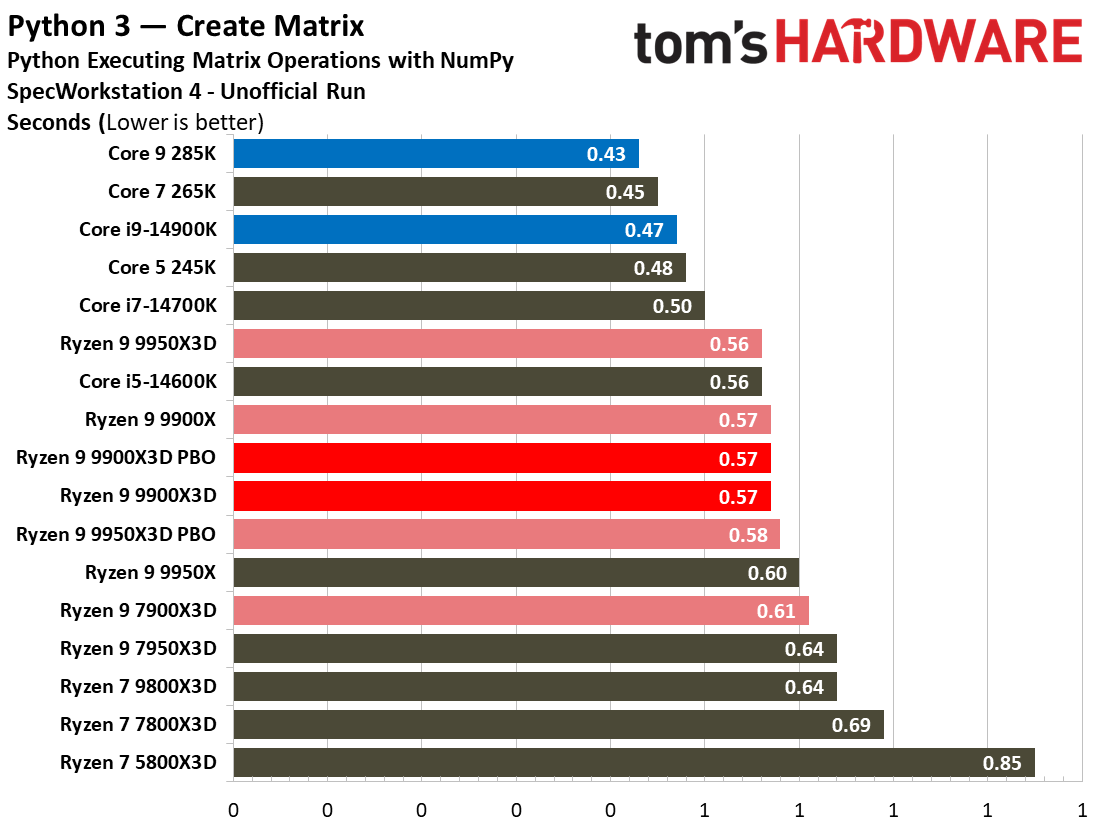
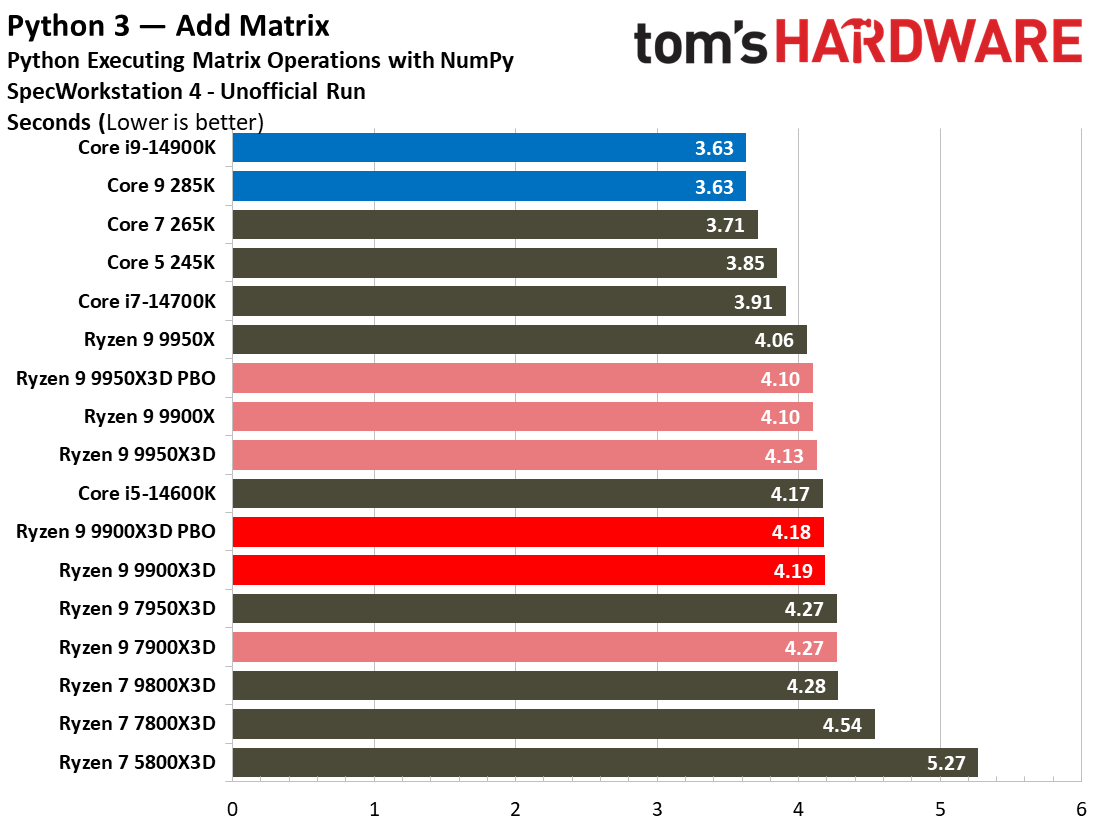
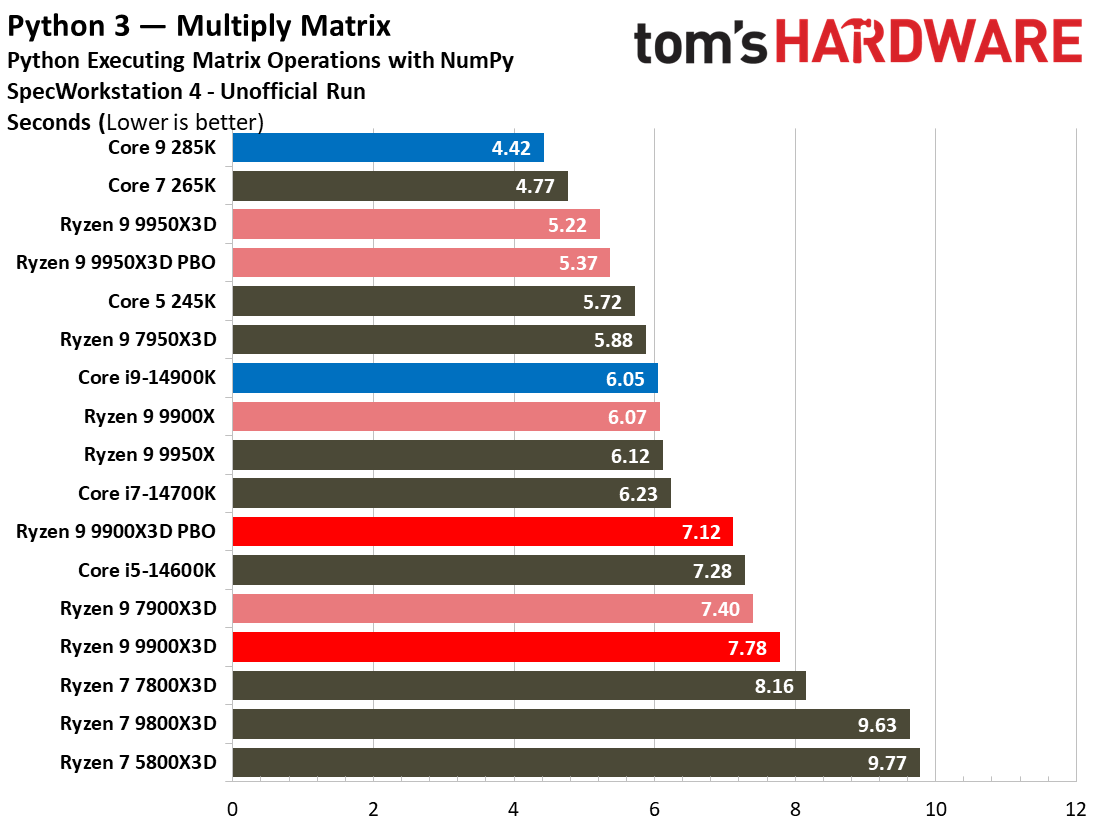
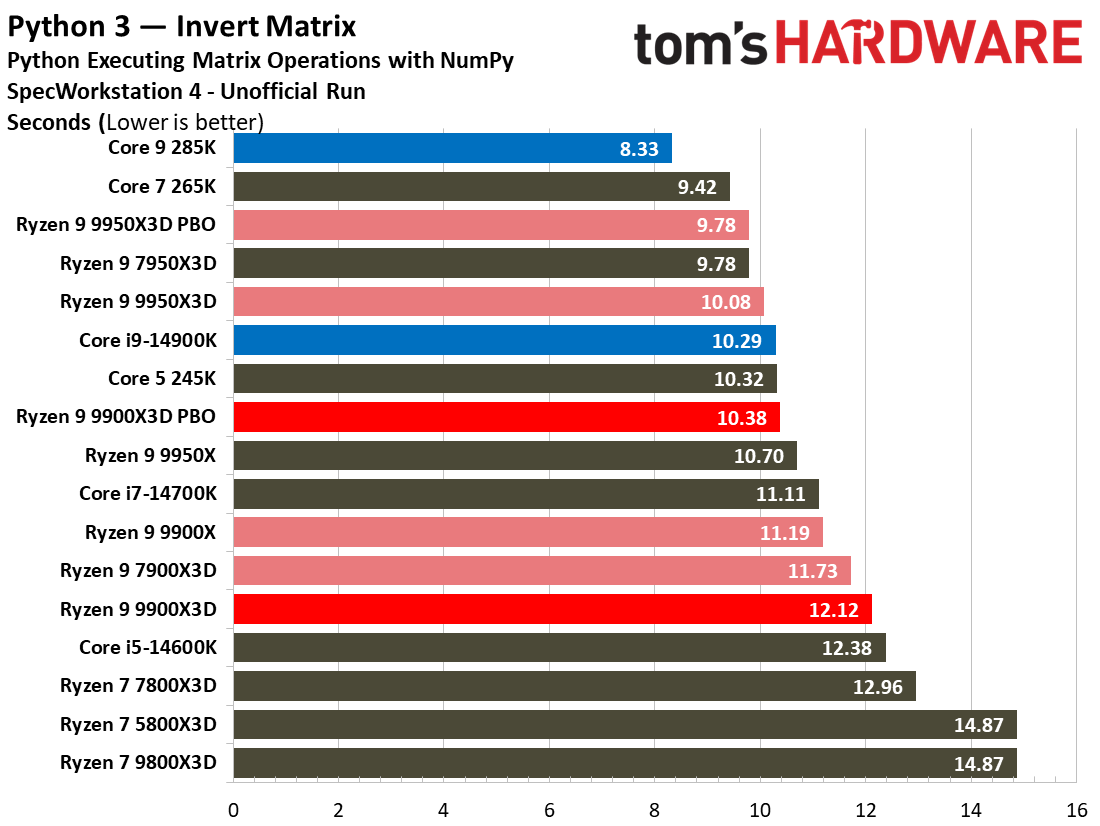
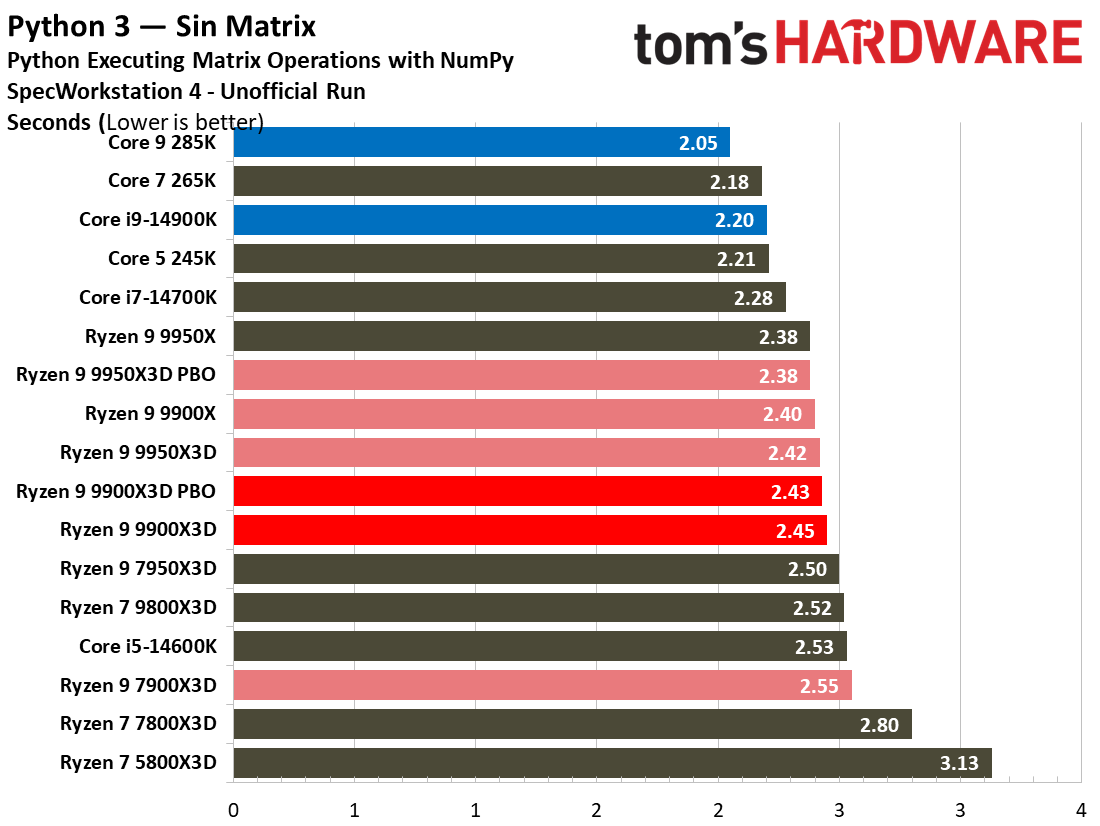
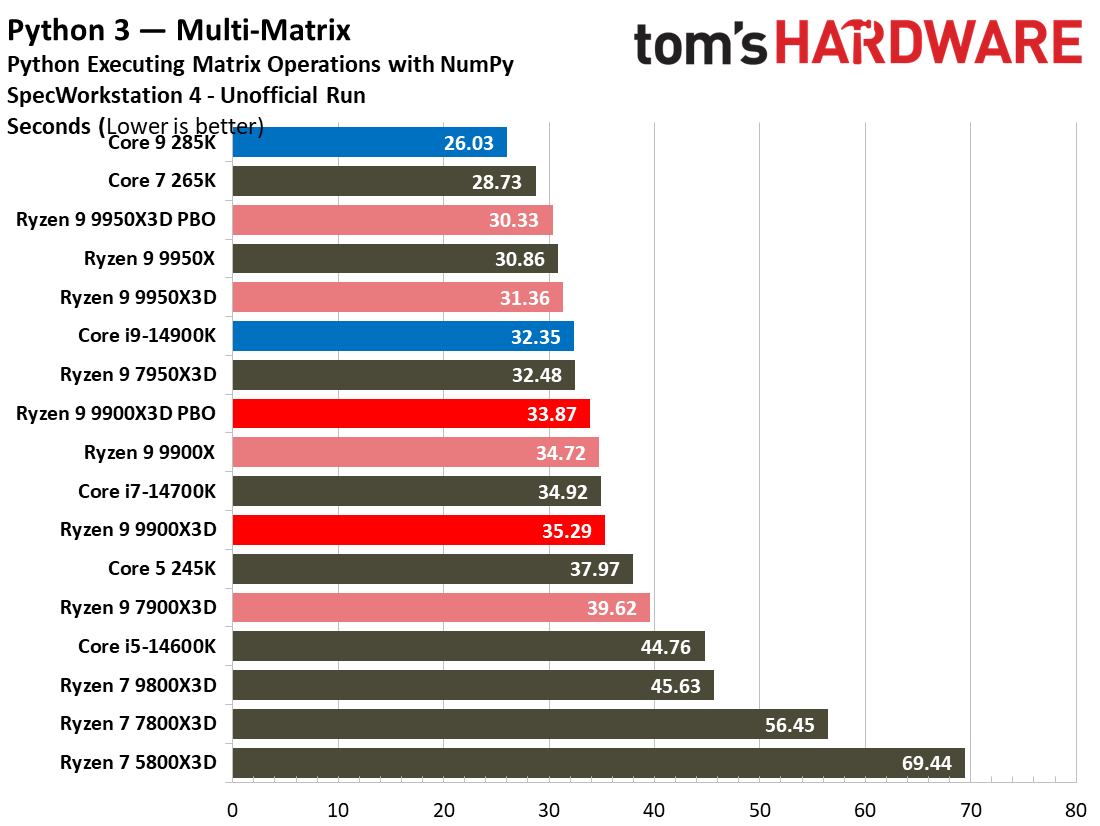
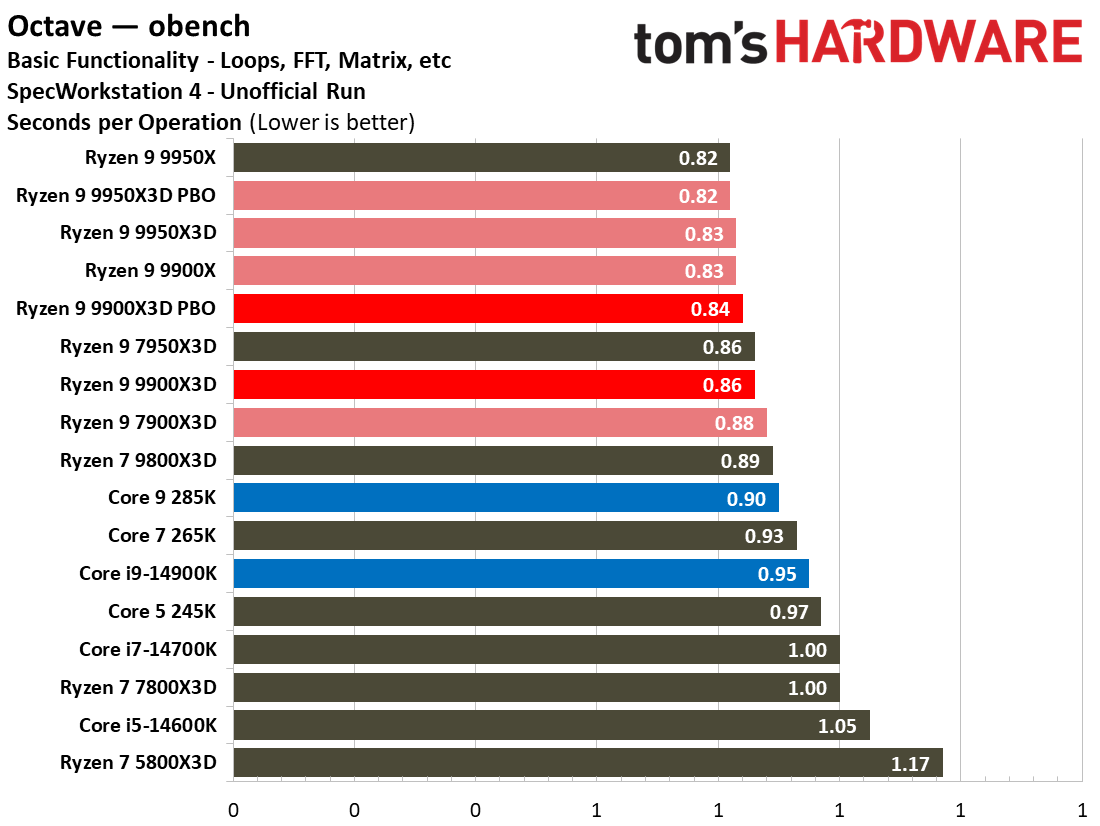
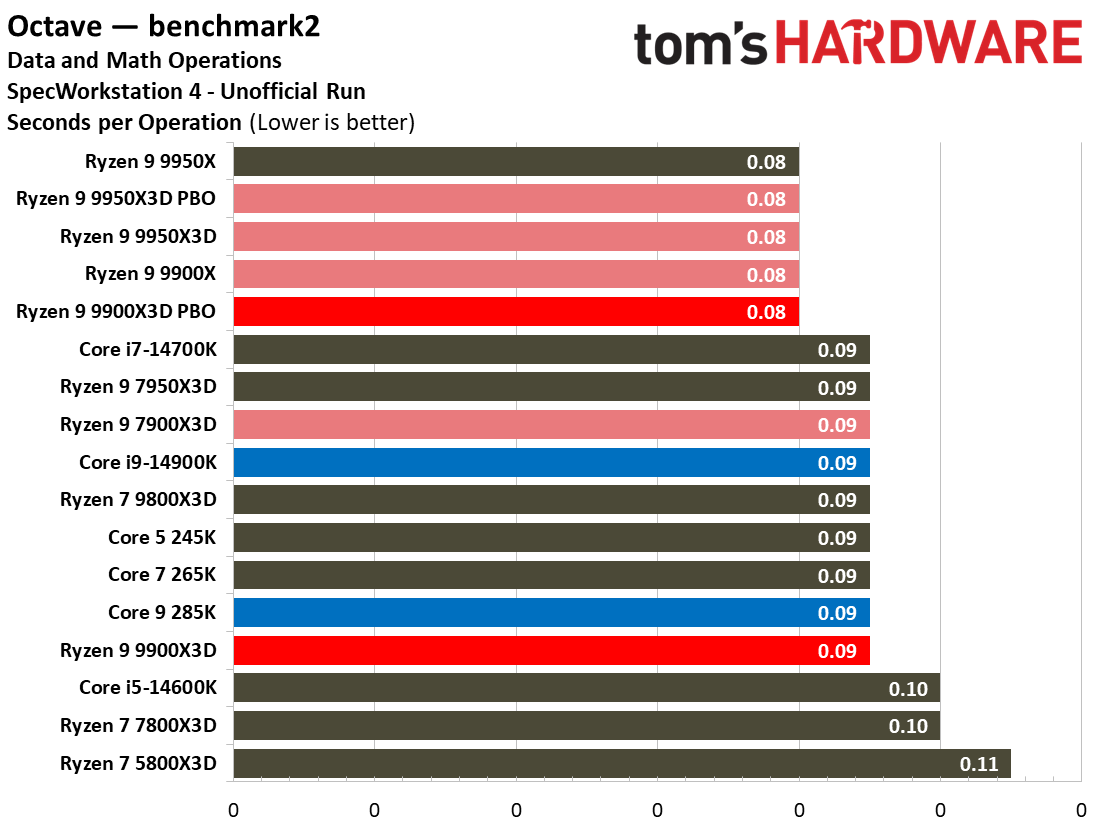
The Productivity and Development vertical addresses software development, code compilation, general office productivity, and related activities. The CPU-sensitive tests in this lineup include extensive Python 3 benchmarks using the NumPy library and the LLVM code compilation benchmark. Intel wins those benchmarks across the board. AMD is more competitive in the Octave benchmarks, taking the lead.
AI and Machine Learning
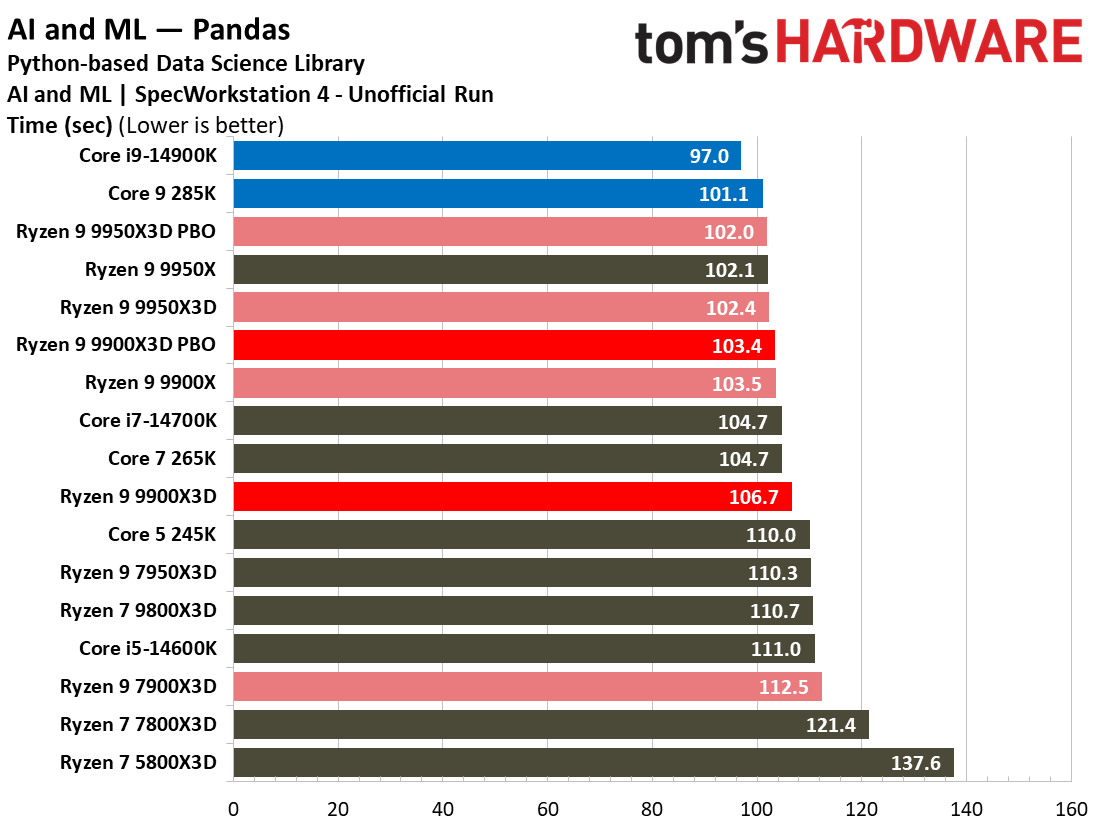

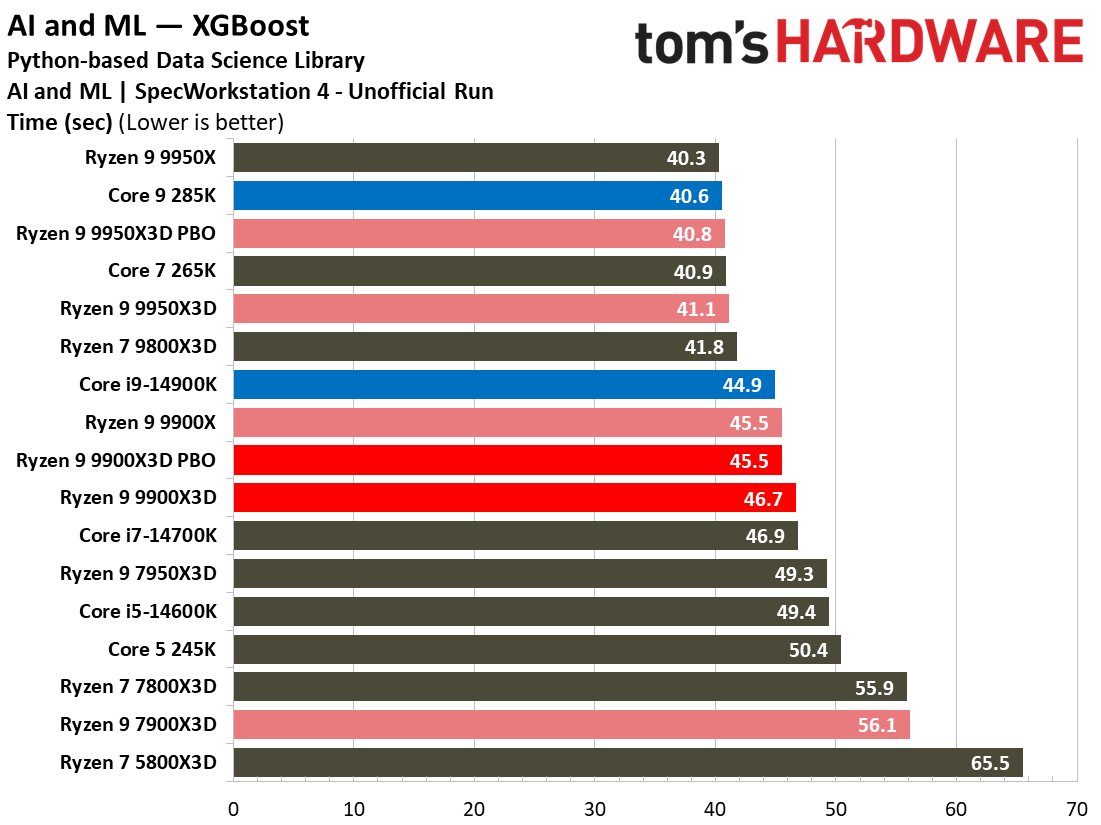
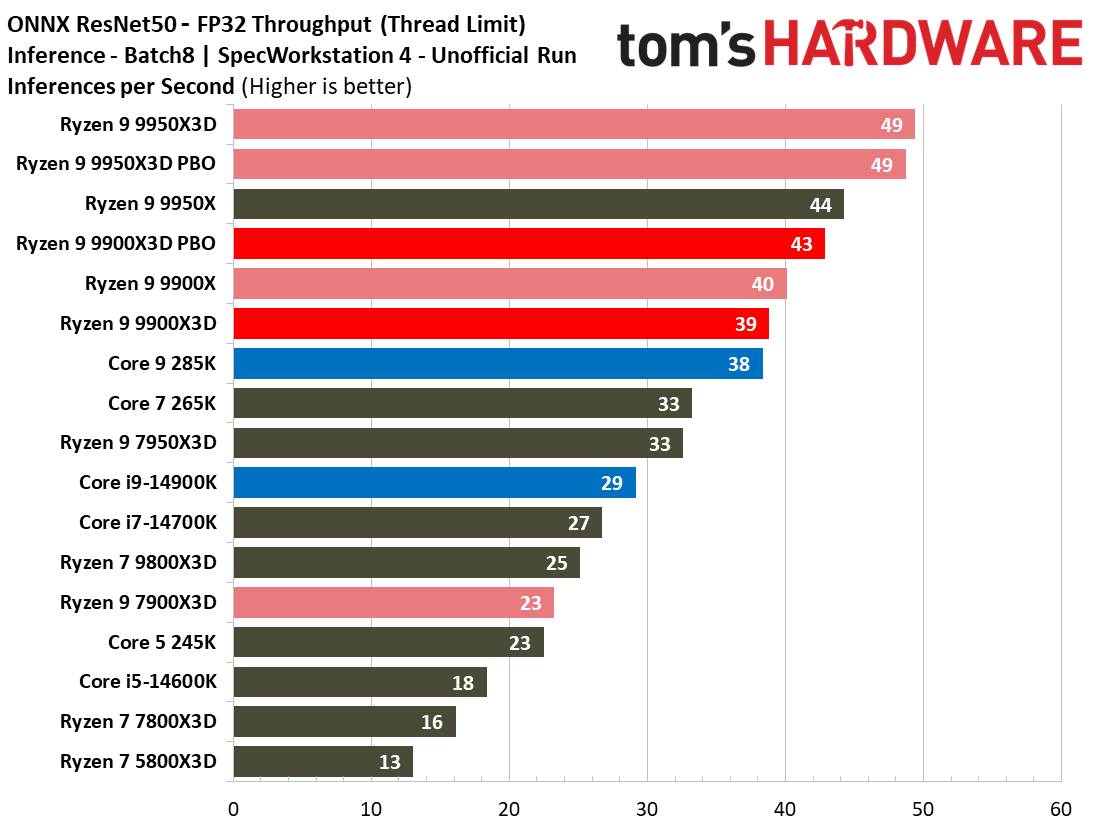
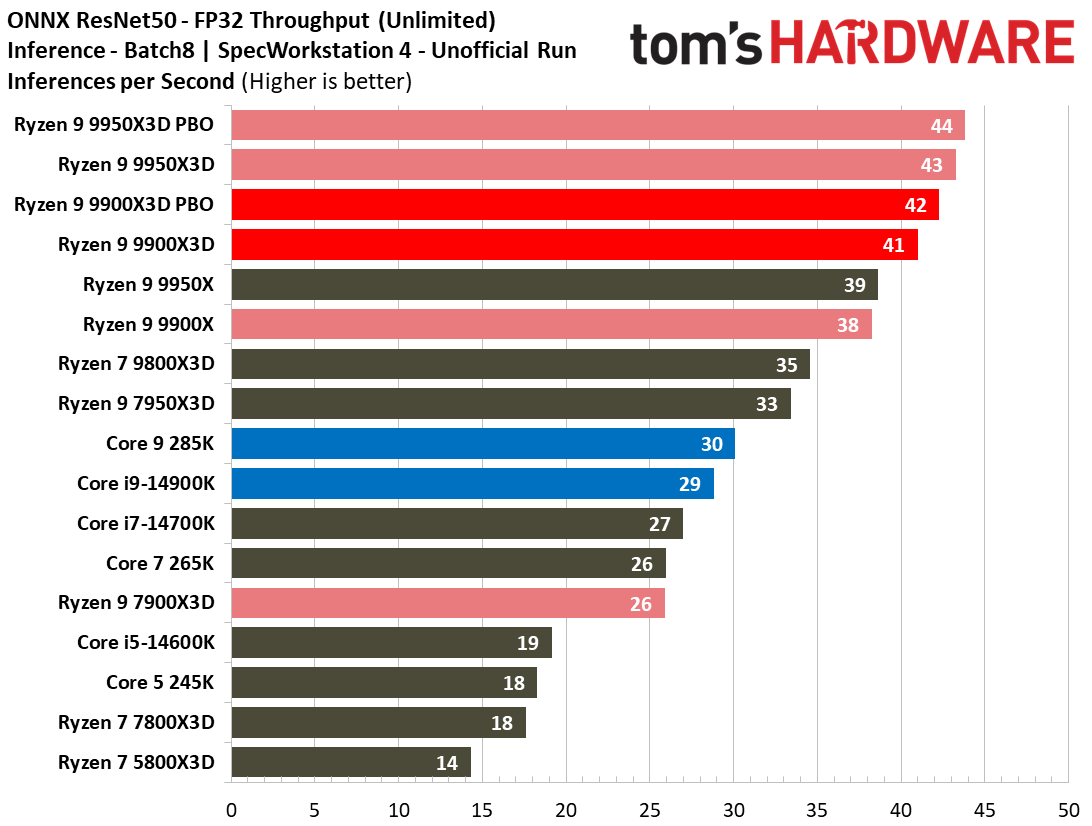
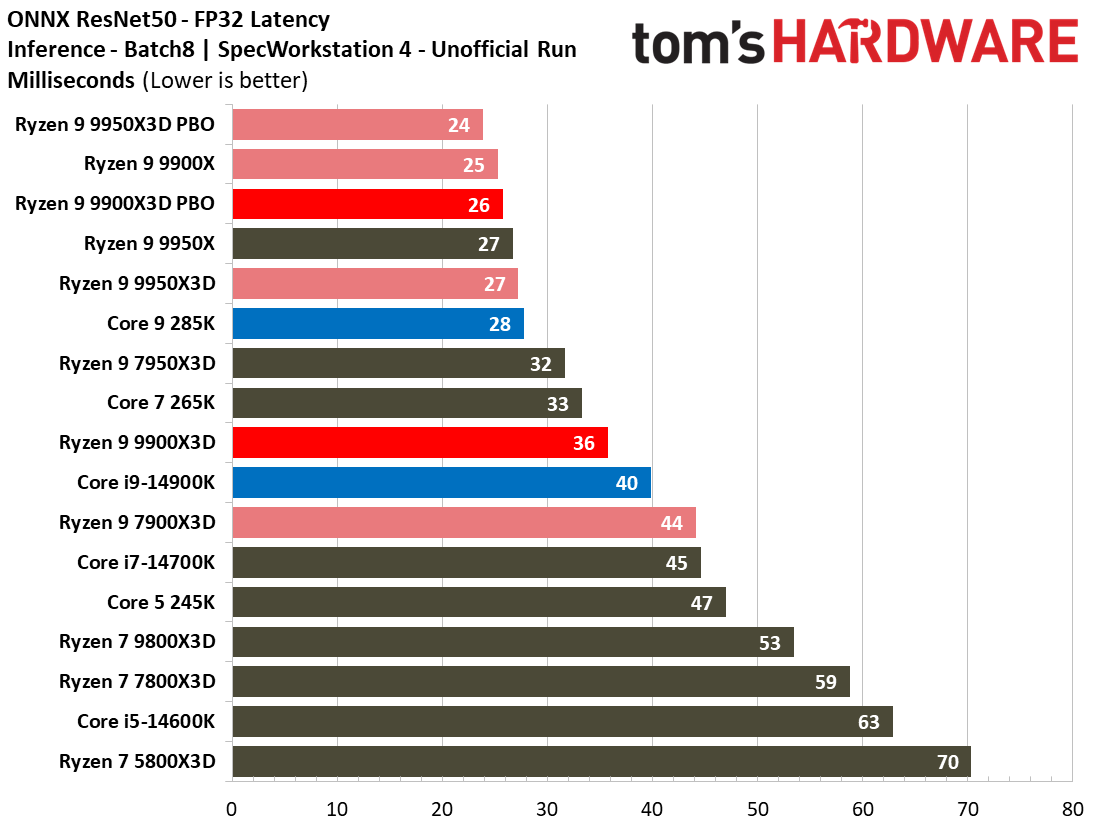
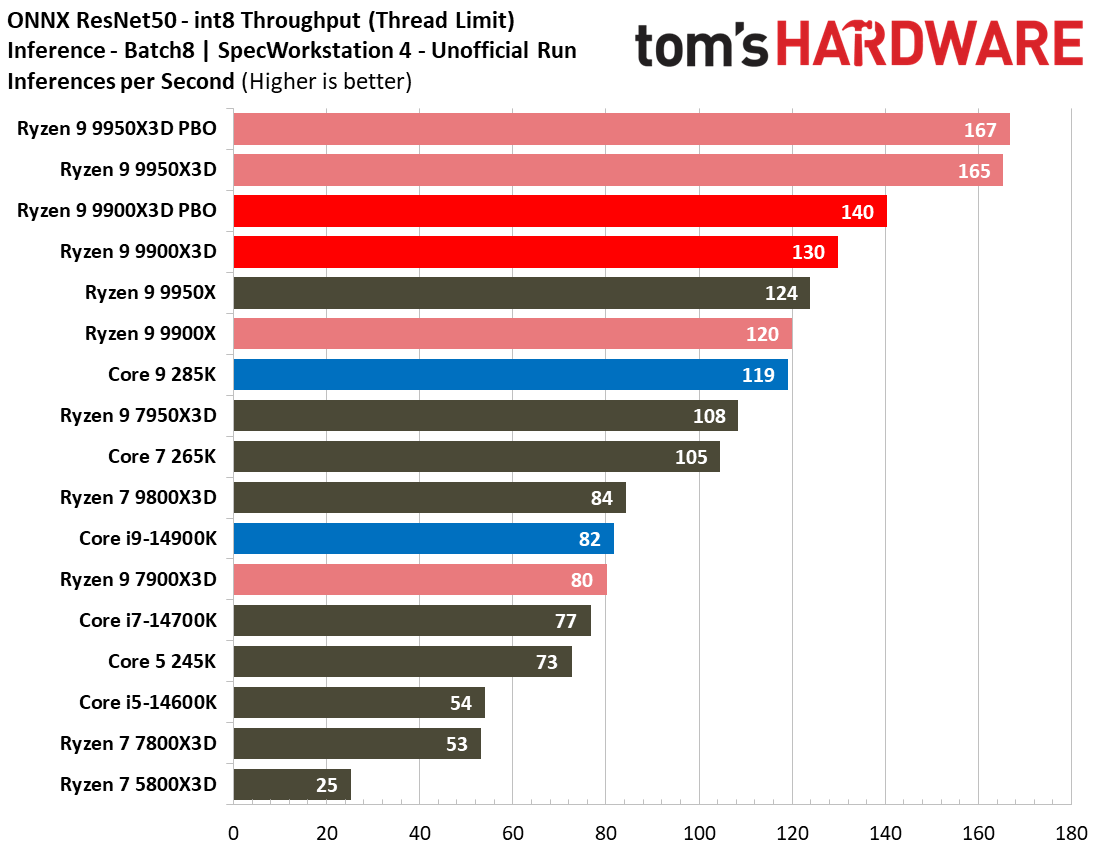

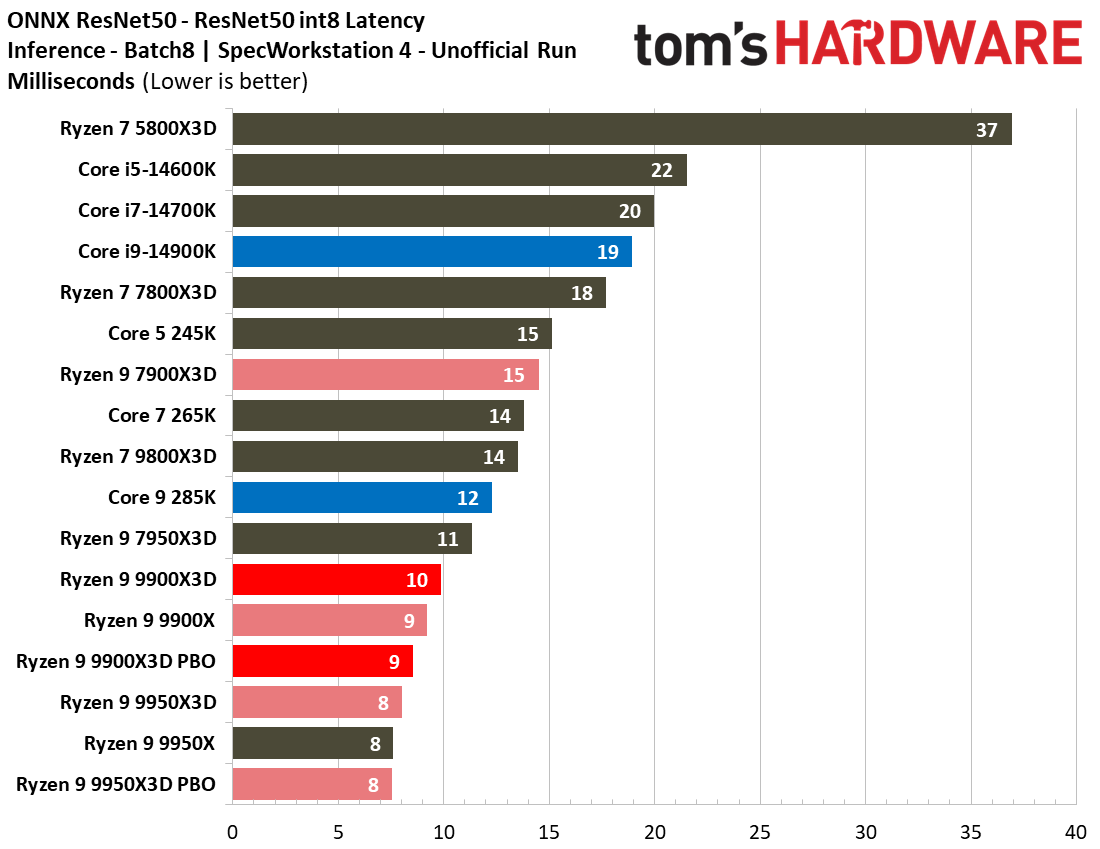
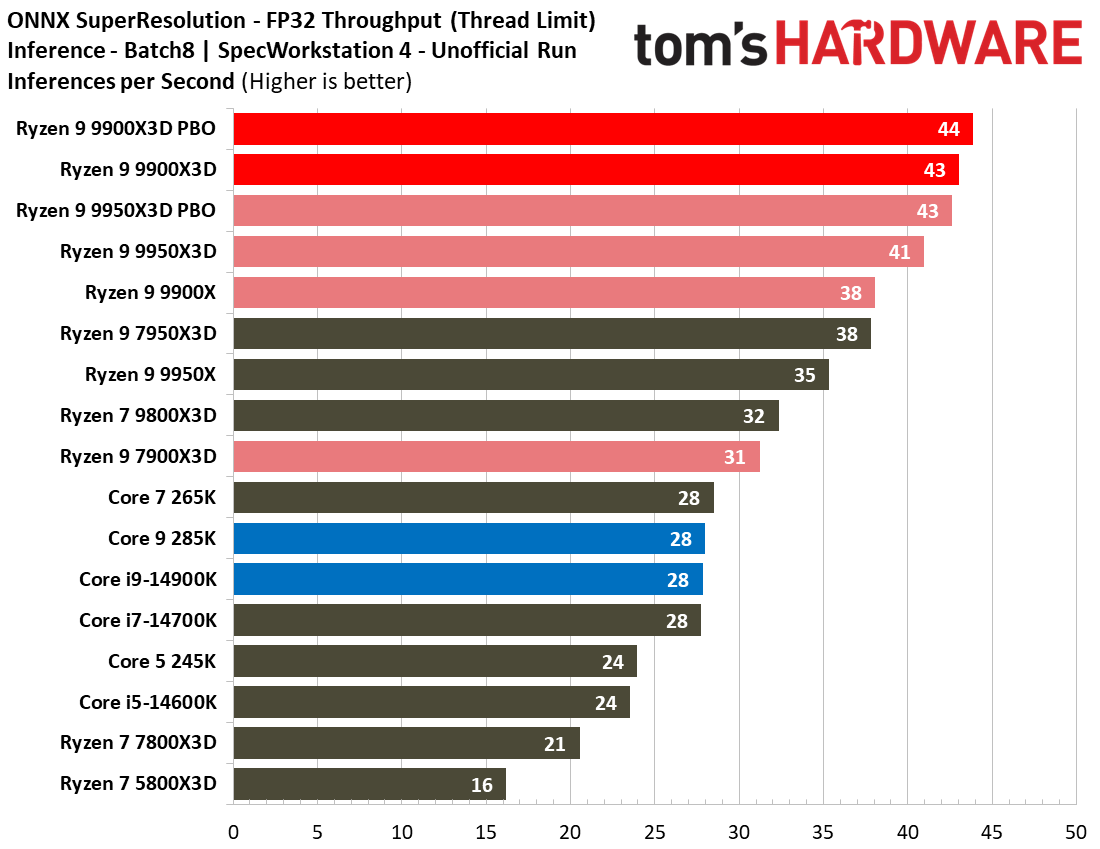
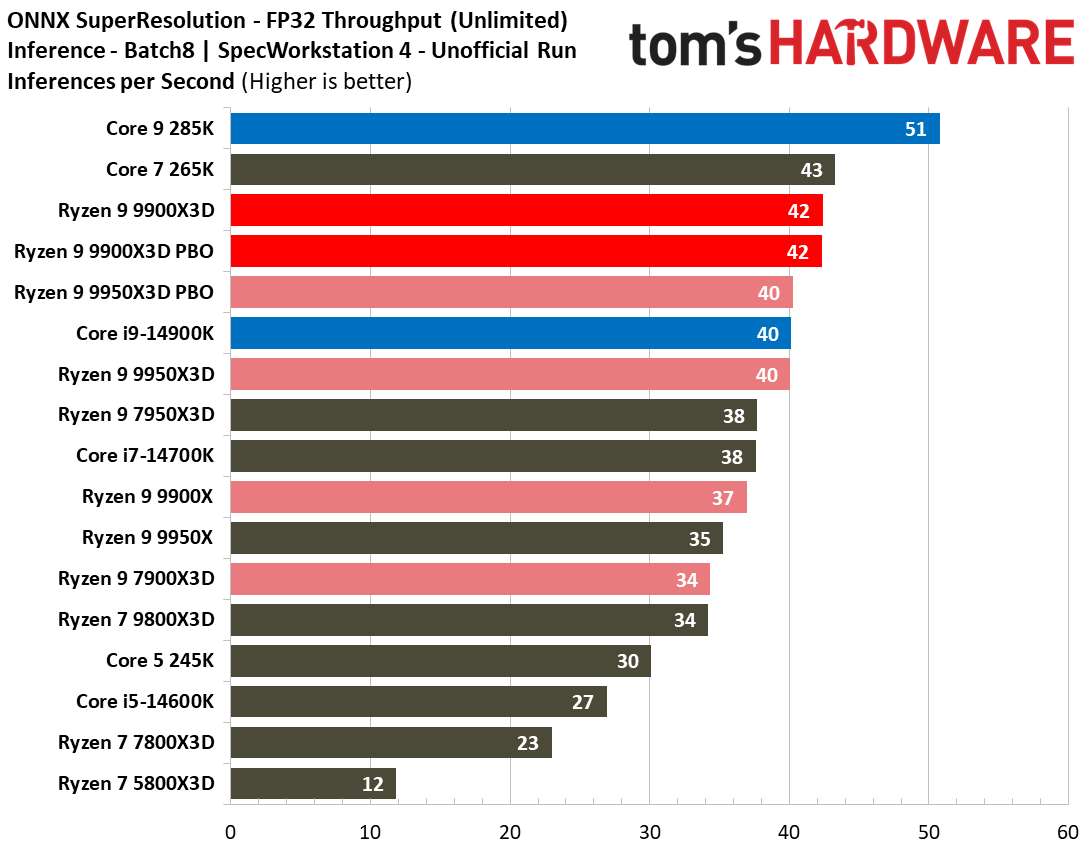
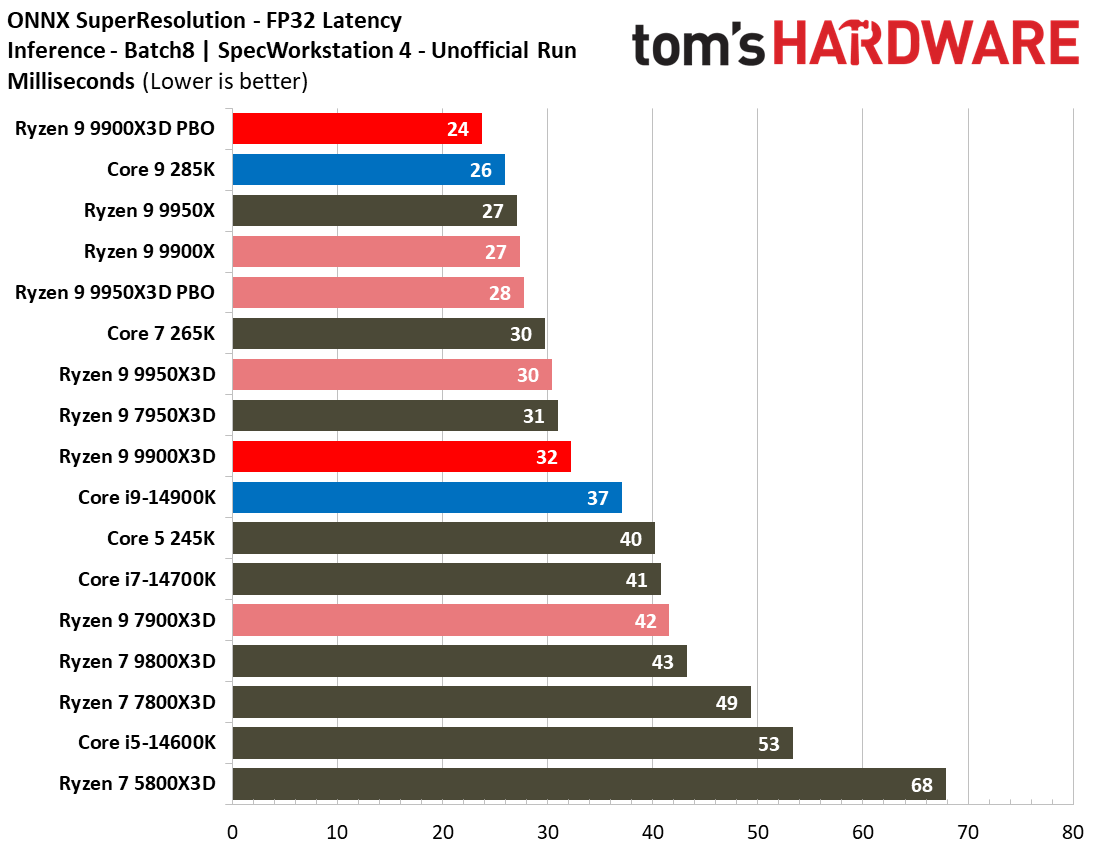
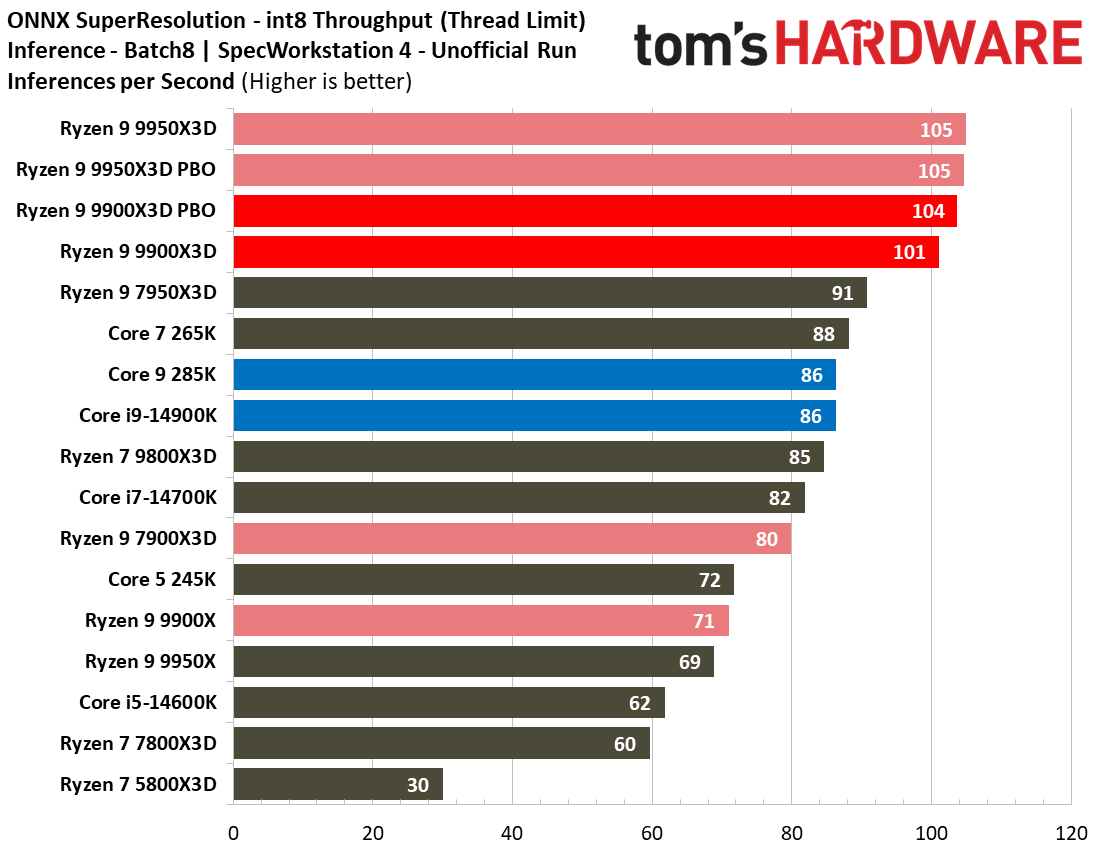


The AI and Machine Learning vertical is one of the most important of the new benchmarks in SPECworkstation 4, as unleashing the power of AI on workstation-class workloads can deliver groundbreaking capabilities. AMD generally leads the ONNX throughput benchmarks in both SuperResolution and RestNet50 flavors, though it's more competitive in the int8 benchmarks.
The Intel chips also excel in the AI and ML benchmarks using the Pandas, Scikit-learn, and XGBoost Python-based data libraries.
Life Sciences
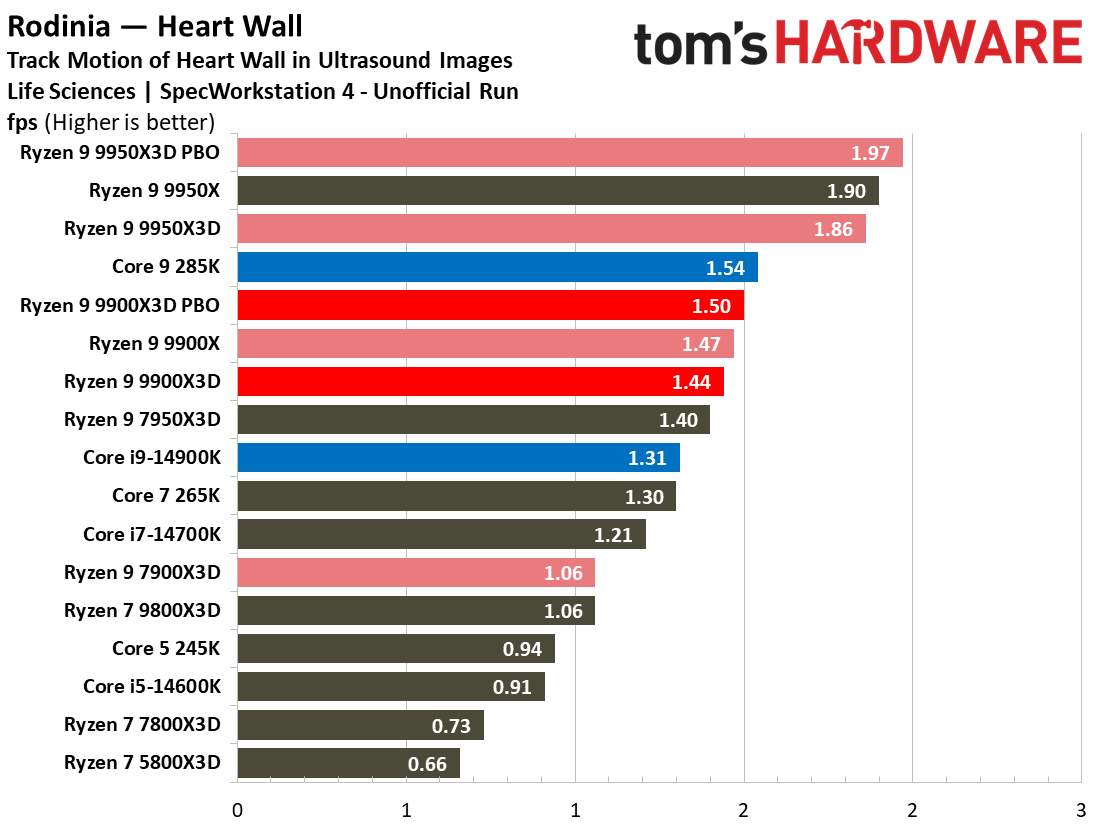
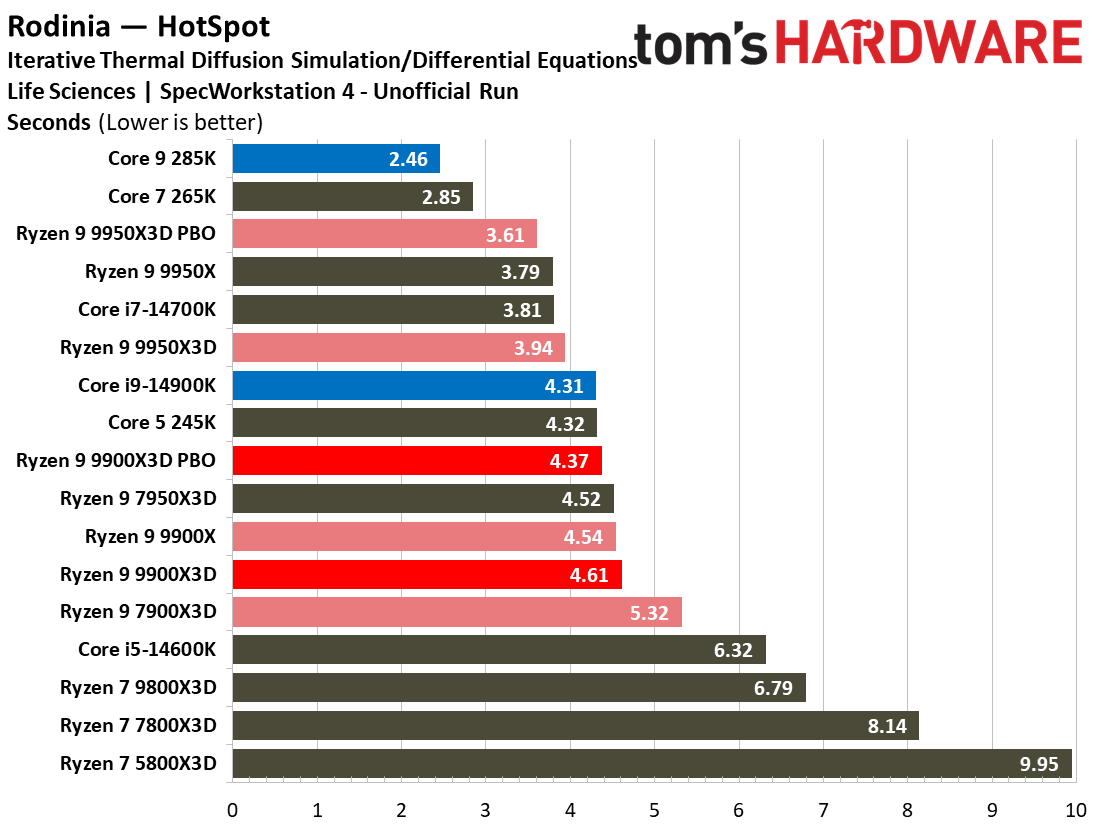

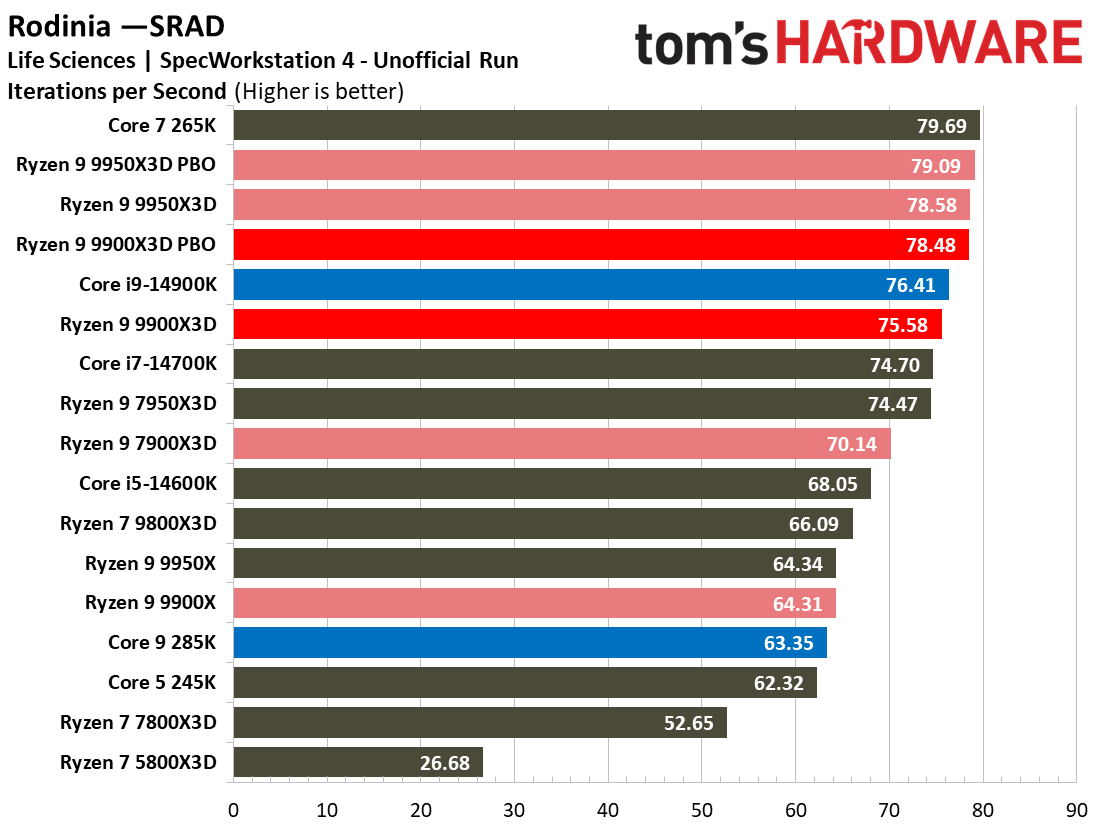
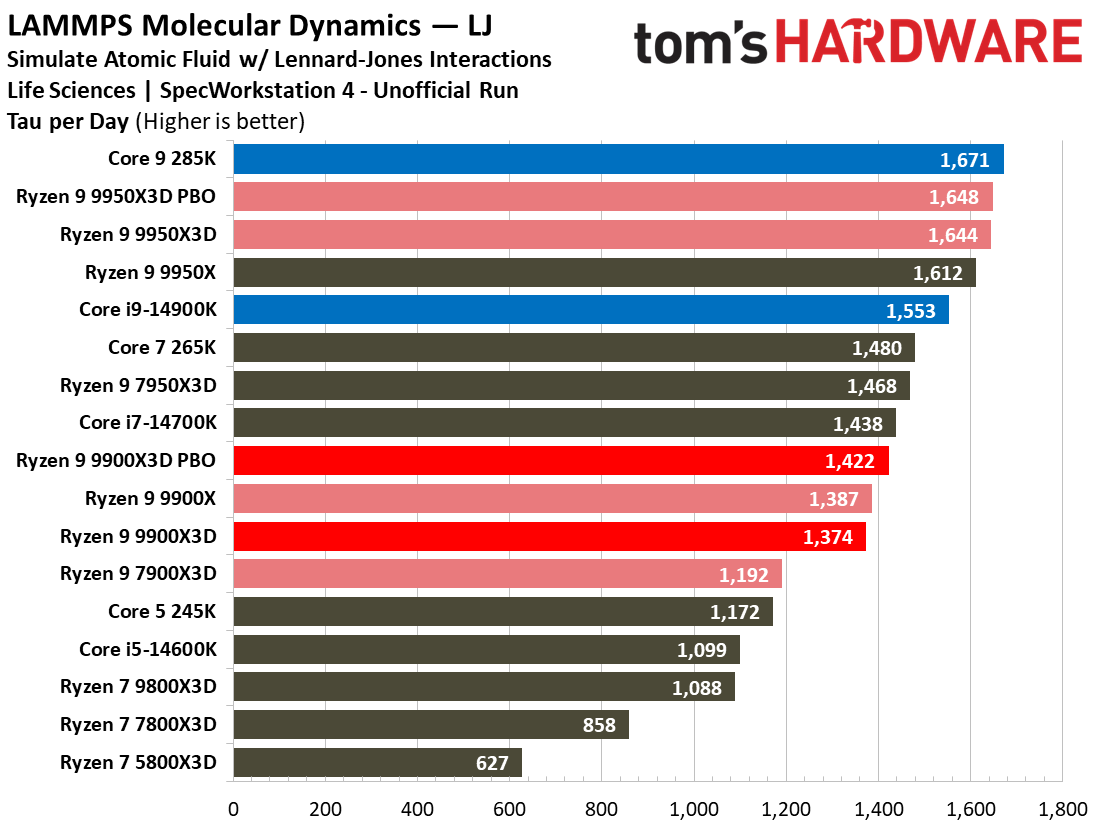
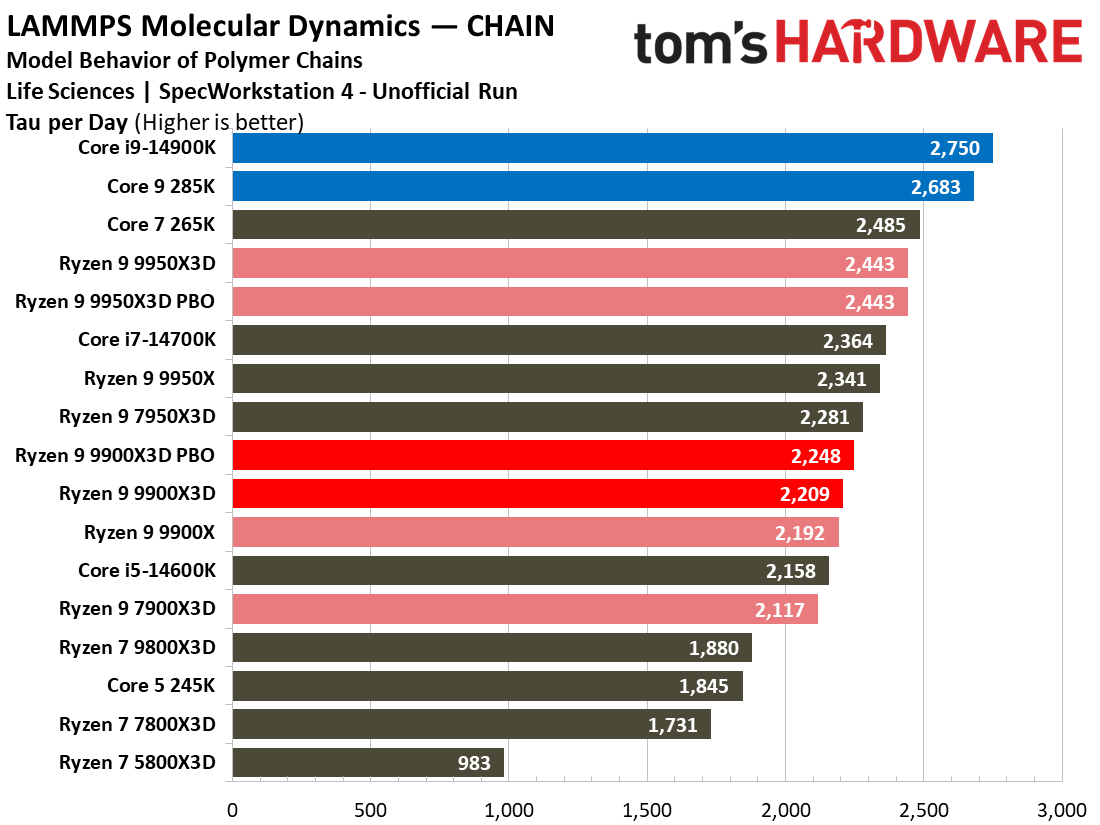
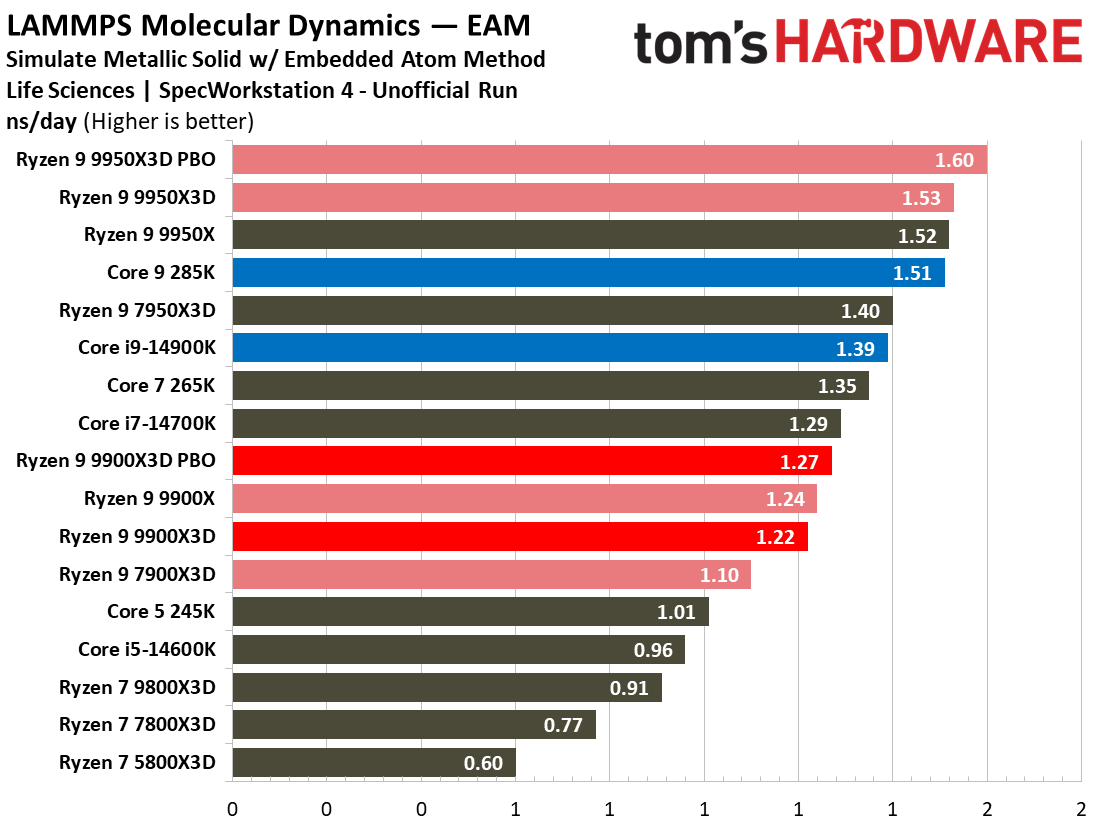
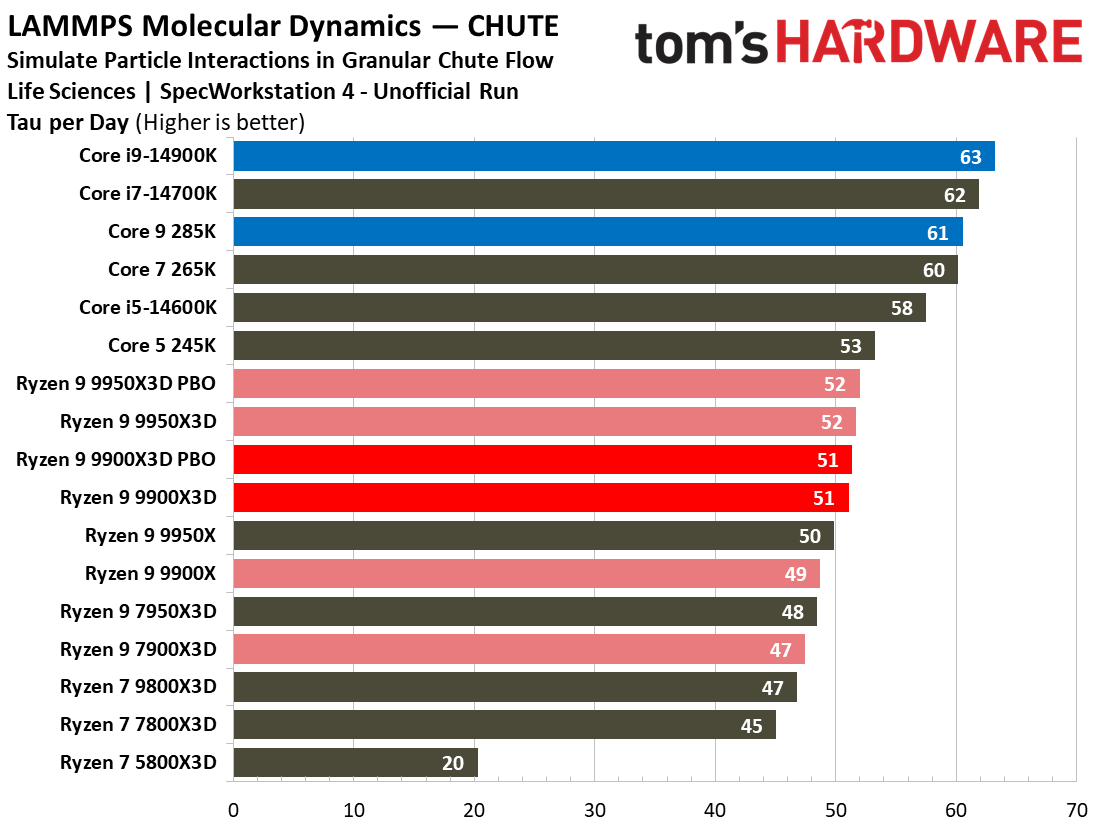
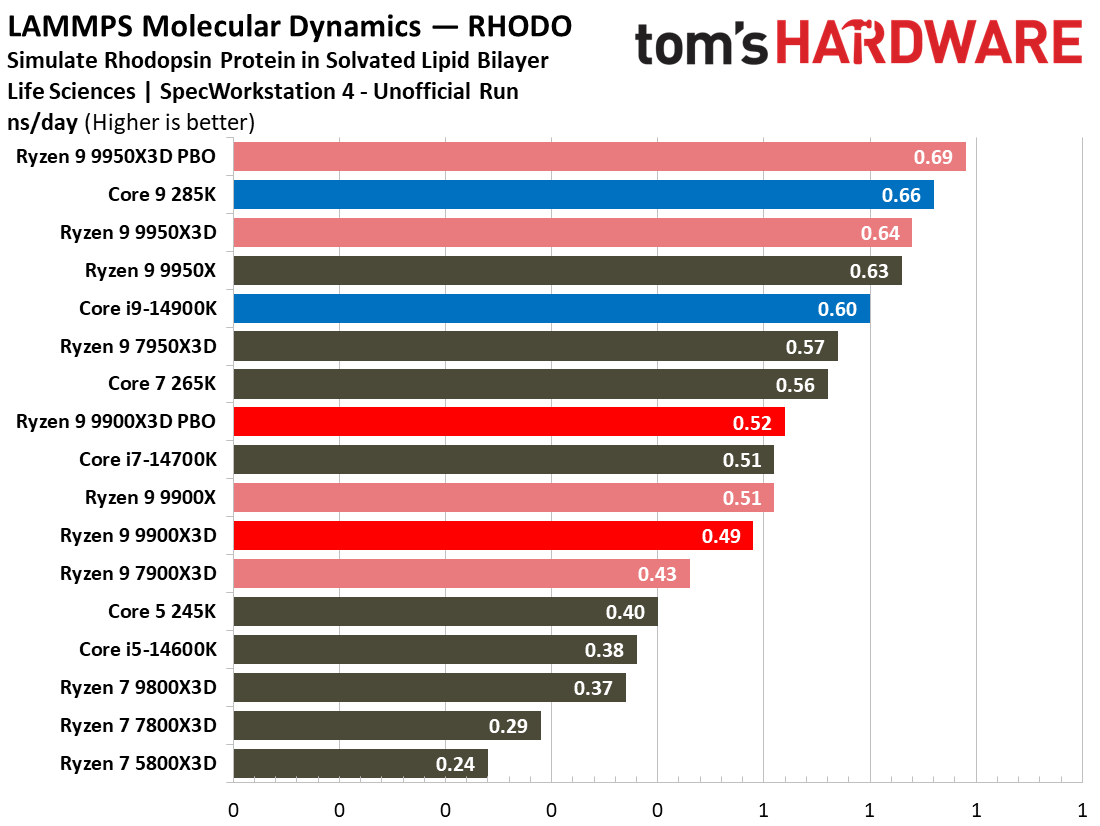
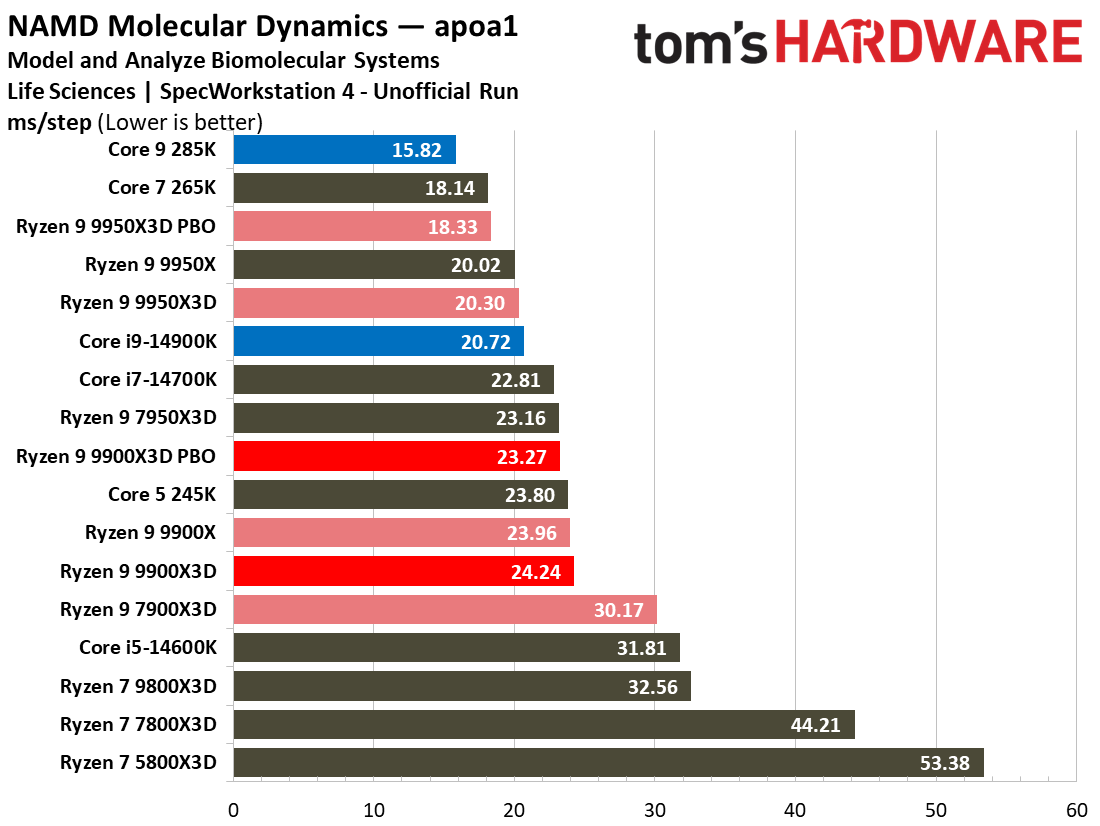
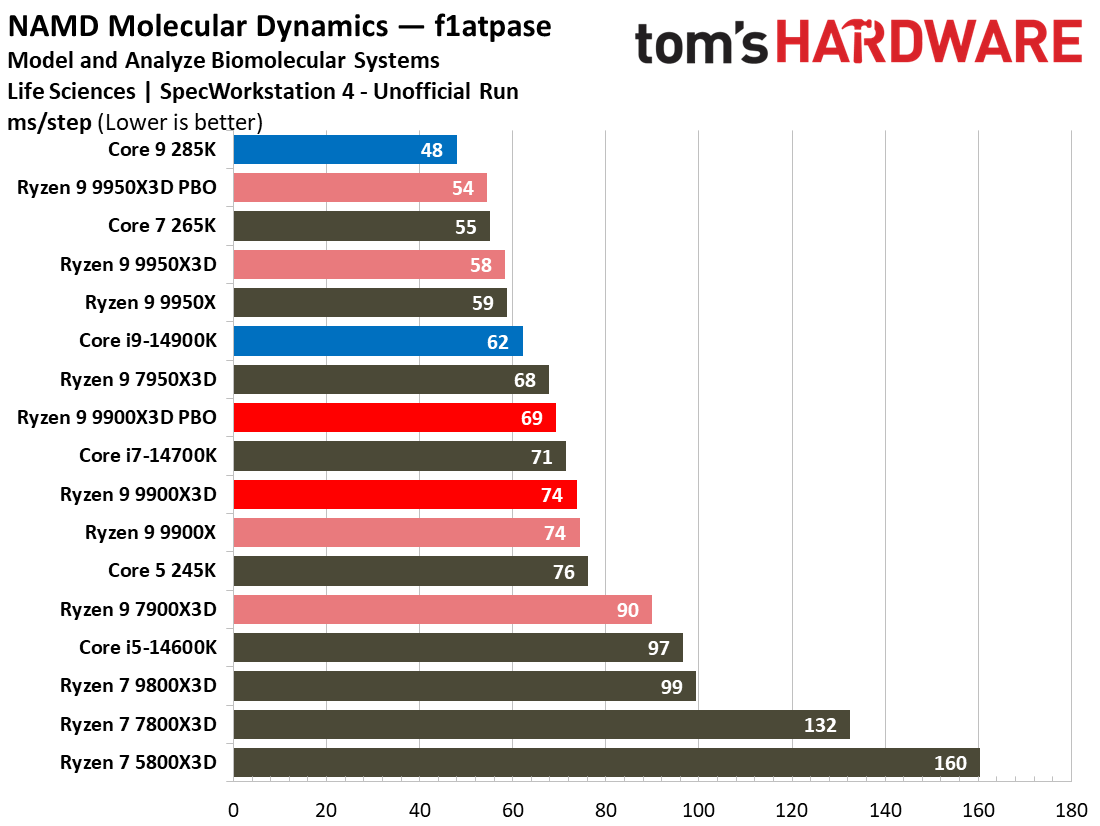
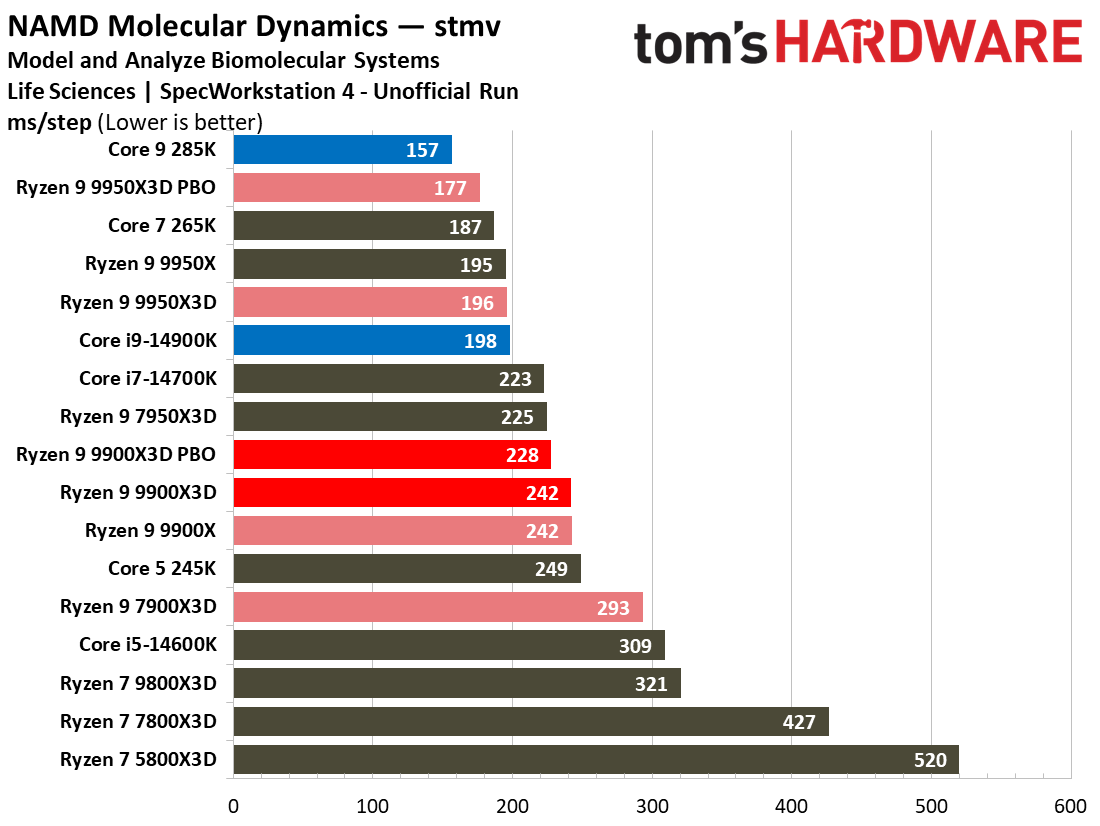
The Life Sciences vertical measures performance in medical imaging, genomics, molecular modeling, and pharmaceutical research workloads. For instance, the Rodinia Heart Wall test tracks the motion of the heart wall in a medical ultrasound image. The LAMMPS and NAMD benchmarks quantify performance in various molecular dynamics simulations.
- MORE: Best CPU for gaming
- MORE: CPU Benchmark Hierarchy
- MORE: Intel vs AMD
- MORE: How to Overclock a CPU
Get Tom's Hardware's best news and in-depth reviews, straight to your inbox.
Current page: Ryzen 9 9900X3D SPECworkstation 4 Benchmarks
Prev Page AMD Ryzen 9 9900X3D Productivity Benchmarks Next Page AMD Ryzen 9 9900X3D Power Consumption, Efficiency, Test Setup
Paul Alcorn is the Editor-in-Chief for Tom's Hardware US. He also writes news and reviews on CPUs, storage, and enterprise hardware.
-
m3city High power usage in iddle, really? One could draw some conclusions based on graphs provided, but definitely not that.Reply -
Neilbob Really not sure why AMD are bothering with the #900 X3D variants. Neither the price or the performance fit, in either direction. Those 6 core chips with the extra cache would be far better diverted to a cheaper #600 X3D if there are enough defective dies to bother, that is.Reply
If it was another 50-75 of your chosen currency cheaper, then it might be more interesting. -
logainofhades I agree that they should just sell these dies as a 9600x3d, and skip the 9900x3d altogether.Reply -
Heat_Fan89 From reading and hearing several reviews (Gamers Nexus), i'm surprised that the 9950X3D and 9900X3D did not demolish the lesser and older 9800X3D. In fact Steve Burke from GN, said the 9950X3D was on par with the 9900X3D and 9800X3D. I decided for my gaming build to go with the 9800X3D, not because of price but the 9800 was the choice for a gaming rig. I recently snagged a new 9800X3D on sale from Amazon for $443.Reply -
JarredWaltonGPU Reply
Why not? Are you missing these charts?m3city said:High power usage in idle, really? One could draw some conclusions based on graphs provided, but definitely not that.
https://cdn.mos.cms.futurecdn.net/Wpec6VRKFNm8Yz2XX46WN3.pnghttps://cdn.mos.cms.futurecdn.net/MZ7DJqYn2gNn4vTHK9aWJ3.png
In idle and light workloads, AMD's CPUs are sitting about 14~17 watts higher than the Core Ultra 9 285K. Is that a terrible thing that should prevent people from buying it? No, but it is a weakness of AMD's design right now. It's something AMD should look into addressing with future designs. Because even though it's only 15W or so (that's two 60W LED bulb equivalents), it should be possible to get that power use down.
Imagine a phone or mobile device that used almost 3X more power at idle than the competition. That would be a major concern. And in light workloads like YouTube, if it had to use twice as much power, that would also be bad.
Some people seem to think the pros and cons are us screaming "THESE ARE AMAZING ASPECTS" and "THESE ARE TEH WORST ASPECTS" but they're really just a high-level summary of some key points — things that are going well, things that could be improved (without the shouting).
I'm not sure why anyone would be surprised that, in gaming, the 8-core X3D and the 8-core X3D plus 8-core standard CCDs perform better in games than a 6-core X3D plus 6-core standard configuration. The whole point of the X3D is to shift cache-sensitive workloads to that CCD, away from the other CCD that lacks the extra cache.Heat_Fan89 said:From reading and hearing several reviews (Gamers Nexus), i'm surprised that the 9950X3D and 9900X3D did not demolish the lesser and older 9800X3D. In fact Steve Burke from GN, said the 9950X3D was on par with the 9900X3D and 9800X3D. I decided for my gaming build to go with the 9800X3D, not because of price but the 9800 was the choice for a gaming rig. I recently snagged a new 9800X3D on sale from Amazon for $443.
It's a whitelist software solution (meaning, AMD explicitly lists which games should effectively disable the non-X3D CCD), and not everything benefits. But as we've seen plenty of times in the past, the dual-CCD (and quad-/hex-/octal-CCD Threadripper) solutions add latency to memory and cache transactions and that reduces gaming performance.
In fact, that's precisely the problem Intel has with Arrow Lake: higher memory latency means lower gaming performance. -
usertests Reply
Higher margin on the chip, perhaps? Although the street price is already below MSRP.Neilbob said:Really not sure why AMD are bothering with the #900 X3D variants. Neither the price or the performance fit, in either direction. Those 6 core chips with the extra cache would be far better diverted to a cheaper #600 X3D if there are enough defective dies to bother, that is.
This should be the last hurrah for the awkward AMD 12-cores. Zen 6 will move to 12-core chiplets. The equivalent chip in that lineup might have 16, 18, or 20 cores, a minimum of 8 cores in each CCX. The 3D cache whitelisting problem could persist, but the single-CCD 9800X3D successor will have 12 cores and walk all over the 9900X3D in every scenario. -
Neilbob Reply
Oh, I definitely understand the reason for it, but I like to delude myself in to thinking that AMD would do something 'nice' for us dinky liddle consumers. I know; I may as well wish for world peace, with a mysterious multi-million inheritance thrown in.usertests said:Higher margin on the chip, perhaps? Although the street price is already below MSRP.
Then again, I can't see how a 9600X3D wouldn't sell like hot cakes at 300, or even a bit more. -
usertests Reply
The other reason they are wary of doing a wide, early release of 6-core X3D is because it clearly undercuts the 8-core X3D for the many games that are fine running on 6 fast cores.Neilbob said:Oh, I definitely understand the reason for it, but I like to delude myself in to thinking that AMD would do something 'nice' for us dinky liddle consumers. I know; I may as well wish for world peace, with a mysterious multi-million inheritance thrown in.
Then again, I can't see how a 9600X3D wouldn't sell like hot cakes at 300, or even a bit more.
They could probably get away with charging $350 for a 9600X3D, but if it costs about the same to make as $480+ 9800X3D due to high yields, a chunk of money is left on the table. So it will probably get introduced much later in this generation when enough defective chips are accumulated, following the pattern. -
Albert.Thomas "We measured the Core Ultra 9 285K at 20W under these conditions, but the Ryzen 9 9900X3D consumed 37W. While we can see that the 9900X3D has improved compared to the previous-gen Ryzen 7000X3D models, this is still a significantly higher amount of active idle power draw than the Intel chips."Reply
What about medium-light conditions Paul?
I've been able to pull a (relatively) insane amount of power with the 9950X3D just by spinning my mouse around really quickly.
With the disclaimer that I haven't tested this in detail, it appears that AMD's flagship X3D CPU is much less efficient below 100W, but is more efficient above 100W. -
Notton What AMD really needs is an 8+4, not a 6+6Reply
Although, judging by the amount of binned 4-cores they sell, it seems the yields are so good they have almost none.
